Physical Address
304 North Cardinal St.
Dorchester Center, MA 02124
Ultrasound can reliably characterize renal duplication, fusion, and rotational anomalies.
Ultrasound is useful in evaluating renal, ureteral, and bladder anatomy in patients with suspected hydronephrosis.
Contrast-enhanced voiding urosonography (CEVUS) is a promising technique that may eventually replace conventional voiding cystourethrography (VCUG) in selected cases.
Ultrasound is used to assess renal size and to exclude anatomic abnormalities as the cause of acute kidney injury (AKI).
Ultrasound is the initial imaging study of choice in patients with suspected urolithiasis, with noncontrast computed tomography reserved for cases in which ultrasound is nondiagnostic.
Intravenous contrast-enhanced ultrasound may provide valuable information regarding renal injury in patients with blunt abdominal trauma.
Ultrasound plays a key role in the evaluation of patients with renal transplants, in both early and later postoperative periods.
Renal ultrasound is often helpful in distinguishing among different types of renal cystic disease.
Ultrasound is employed to distinguish cystic (usually benign) from solid (often malignant) renal masses.
Ultrasound is used to differentiate between neonatal adrenal hemorrhage and neuroblastoma.
Sonography plays a major role in the evaluation of the pediatric urinary tract and adrenal glands. Ultrasound examination of the pediatric urinary tract should include imaging of the kidneys, ureters (if visualized), and urinary bladder. For most patients, no special preparation is required. The child's parents are asked to bring the patient for the study with a full urinary bladder when a study is performed for evaluation of hematuria or urinary tract stones ( Table 52.1 ). These children are requested to drink fluids during the hour before the examination. Patients scheduled for renal Doppler examination should have nothing to eat or drink (NPO) before the study for a time period determined according to patient age. For a young child who is not yet toilet-trained, the bladder should be checked first and frequently because it may fill and empty suddenly.
| Indication | Preparation |
|---|---|
| Hematuria | Full bladder |
| Urinary tract stones | Full bladder |
| Renal Doppler examination | NPO for time period determined according to age |
| <1 year of age: NPO for 2 hours >1 year and <5 years of age: NPO for 4 hours |
|
| ≥5 years of age: NPO for 6 hours | |
| All other indications | None |
Although children vary in their ability to hold still, sedation is rarely needed. Infants younger than 1 year can be fed or given a pacifier during the examination. The patient older than 1 year can be distracted or entertained by watching movies, playing with toys, or reading a book. The addition of cine clips often compensates for movement of the child.
A variety of ultrasound equipment can be used. The highest frequency transducer that will penetrate the area being examined is optimal. Harmonic imaging may aid in visualization of the difficult-to-scan patient. Different types of transducers are used for different parts of the body. Scans of the kidneys from the back are best performed with a linear or curved linear transducer, whereas frontal scans of the kidney are best performed with a curved linear or sector transducer that penetrates between the ribs. Views of the bladder are obtained with a curved linear transducer. The ureters are evaluated as they leave the renal pelvis and enter the bladder. Images are recorded and stored on digital media.
Routine examination includes longitudinal and transverse views of both kidneys ( Fig. 52.1 ). In the pediatric patient, the kidneys are imaged in the supine and prone positions. The supine sagittal or coronal image allows optimal visualization of the upper pole, which may be obscured by ribs in the prone position. The echogenicity of the kidney should always be compared with the adjacent liver and spleen. Decubitus positioning is helpful to visualize the upper pole for measurement when the upper kidney is obscured by the ribs. The prone image allows optimal visualization of the lower pole of the kidney, but the upper pole may be obscured by overlying ribs or aerated lung in the costophrenic angle. Kidney volumes can be determined by obtaining a transverse image through the midkidney and measuring its anteroposterior (AP) and transverse dimensions (see Fig. 52.1C ). The formula for determining the volume of a prolate ellipsoid is used:

Normal sonographic measurements of renal length and volume in comparison to patient age, height, weight, and/or body surface area have been determined and are useful in evaluation of the abnormal kidney ( Fig. 52.2 , Tables 52.2, 52.3, 52.4, and 52.5 ). Length and volume data for single functioning kidneys in children have also been reported. Compensatory renal growth of a single functional kidney occurs in utero, and its relative size difference continues throughout infancy and childhood ( Table 52.6 ). Renal size in premature infants has also been compared with gestational age or birth weight ( Fig. 52.3 ). In patients with chronic problems, such as recurrent urinary tract infection (UTI), reflux, or neurogenic bladder, renal growth can be monitored on follow-up examinations.
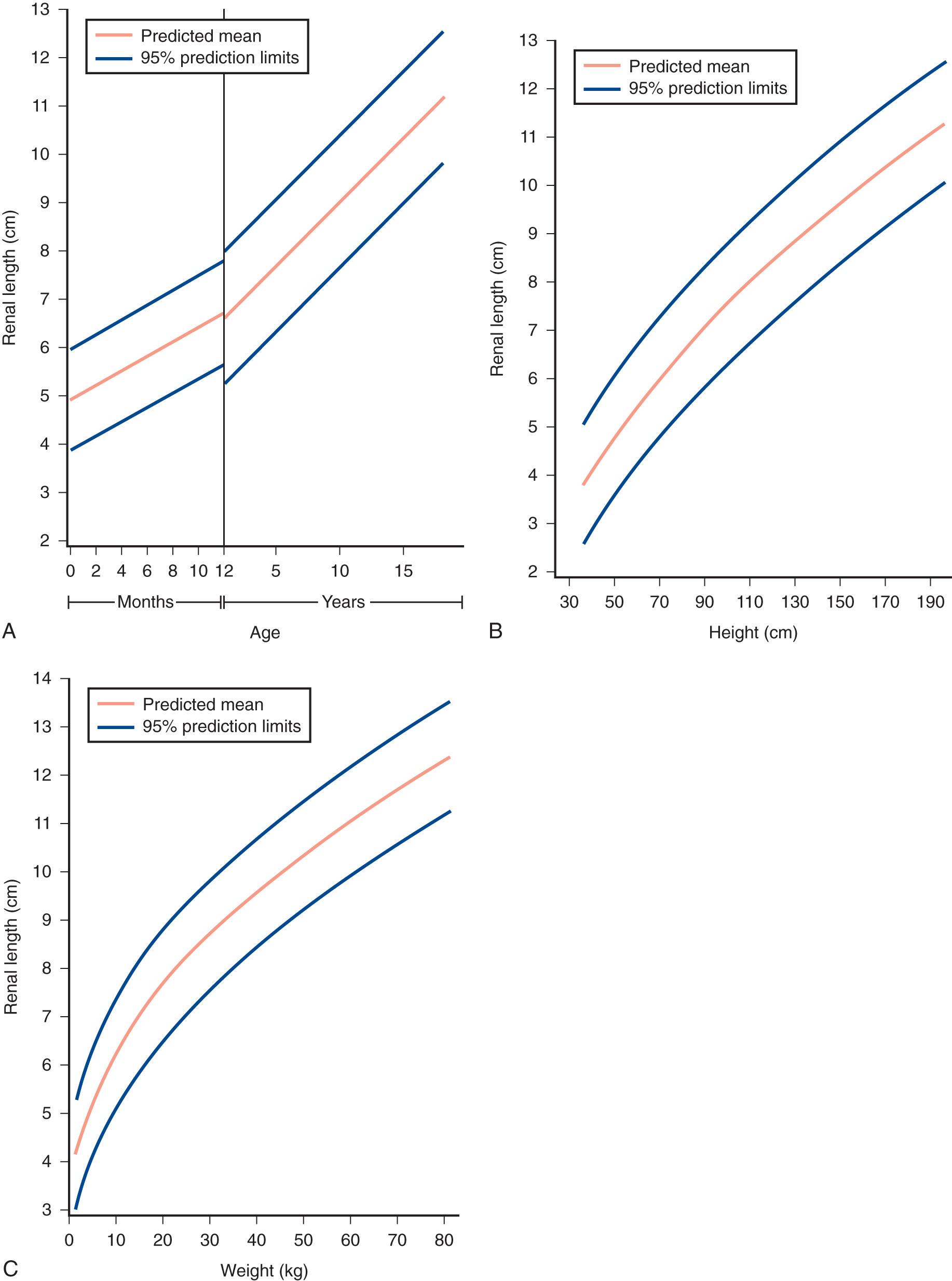
| 95% CI FOR MEAN | PERCENTILE | ||||||
|---|---|---|---|---|---|---|---|
| Gender | Age (Months) | Number | Mean ± SD | Lower Limit | Upper Limit | 3rd | 97th |
| Male | 0-3 | 336 | 4.88 ± 0.56 | 4.82 | 4.94 | 3.9 | 6.0 |
| 3-6 | 238 | 5.69 ± 0.40 | 5.64 | 5.74 | 5.0 | 6.5 | |
| 6-9 | 246 | 5.90 ± 0.41 | 5.85 | 5.96 | 5.1 | 6.8 | |
| 9-12 | 220 | 5.93 ± 0.50 | 5.86 | 6.00 | 5.0 | 6.9 | |
| Female | 0-3 | 246 | 4.75 ± 0.62 | 4.67 | 4.83 | 3.6 | 6.1 |
| 3-6 | 210 | 5.70 ± 0.39 | 5.64 | 5.75 | 5.0 | 6.5 | |
| 6-9 | 250 | 5.73 ± 0.40 | 5.68 | 5.78 | 5.1 | 6.6 | |
| 9-12 | 238 | 6.17 ± 0.50 | 6.10 | 6.23 | 5.1 | 7.0 | |
| 95% CI FOR MEAN | PERCENTILE | ||||||
|---|---|---|---|---|---|---|---|
| Gender | Age (Months) | Number | Mean ± SD | Lower Limit | Upper Limit | 3rd | 97th |
| Male | 0-3 | 336 | 14.32 ± 4.52 | 13.84 | 14.81 | 7.48 | 24.14 |
| 3-6 | 238 | 19.30 ± 4.40 | 18.74 | 19.86 | 12.18 | 30.04 | |
| 6-9 | 246 | 21.50 ± 3.98 | 21.01 | 22.00 | 15.08 | 30.60 | |
| 9-12 | 220 | 24.59 ± 7.17 | 23.64 | 25.54 | 14.68 | 42.49 | |
| Female | 0-3 | 246 | 13.22 ± 4.31 | 12.68 | 13.77 | 6.20 | 21.88 |
| 3-6 | 210 | 18.58 ± 3.85 | 18.06 | 19.09 | 12.43 | 26.74 | |
| 6-9 | 250 | 20.20 ± 3.82 | 19.73 | 20.68 | 13.88 | 28.19 | |
| 9-12 | 238 | 26.48 ± 7.60 | 25.51 | 27.45 | 15.45 | 46.77 | |
| Age (Years) | Mean Age (Years) | No. of Subjects | Total Renal Volume (cm 3 ) |
|---|---|---|---|
| 0.00-0.249 | 0.0 | 99 | 30.83 ± 7.98 |
| 0.25-0.49 | 0.25 | 81 | 44.76 ± 11.03 |
| 0.50-0.99 | 0.5 | 121 | 55.44 ± 6.82 |
| 1.00-1.49 | 1.0 | 111 | 62.80 ± 9.23 |
| 1.50-1.99 | 1.5 | 56 | 68.35 ± 10.64 |
| 2.00-2.49 | 2.0 | 87 | 74.49 ± 10.04 |
| 2.50-2.99 | 2.5 | 98 | 82.47 ± 9.22 |
| 3.00-3.49 | 3.0 | 135 | 89.60 ± 11.89 |
| 3.50-3.99 | 3.5 | 77 | 94.89 ± 9.50 |
| 4.00-4.49 | 4.0 | 115 | 102.01 ± 10.41 |
| 4.50-4.99 | 4.5 | 79 | 106.81 ± 10.90 |
| 5.00-5.49 | 5.0 | 109 | 112.62 ± 13.47 |
| 5.50-5.99 | 5.5 | 129 | 118.44 ± 13.18 |
| 6.00-6.49 | 6.0 | 173 | 123.79 ± 12.04 |
| 6.50-6.99 | 6.5 | 130 | 132.18 ± 12.01 |
| 7.00-7.49 | 7.0 | 142 | 137.00 ± 12.11 |
| 7.50-7.99 | 7.5 | 137 | 144.05 ± 13.26 |
| 8.00-8.49 | 8.0 | 127 | 151.08 ± 14.40 |
| 8.50-8.99 | 8.5 | 79 | 156.15 ± 11.37 |
| 9.00-9.49 | 9.0 | 147 | 163.69 ± 11.93 |
| 9.50-9.99 | 9.5 | 79 | 168.57 ± 11.28 |
| 10.00-10.49 | 10.0 | 125 | 174.16 ± 10.39 |
| 10.50-10.99 | 10.5 | 79 | 183.18 ± 12.69 |
| 11.00-11.49 | 11.0 | 104 | 188.03 ± 12.13 |
| 11.50-11.99 | 11.5 | 50 | 195.24 ± 11.12 |
| 12.00-12.49 | 12.0 | 90 | 201.82 ± 11.65 |
| 12.50-12.99 | 12.5 | 50 | 208.46 ± 12.56 |
| 13.00-13.49 | 13.0 | 87 | 215.00 ± 16.63 |
| 13.50-13.99 | 13.5 | 42 | 218.30 ± 14.83 |
| 14.00-14.49 | 14.0 | 90 | 225.39 ± 16.98 |
| 14.50-14.99 | 14.5 | 45 | 230.14 ± 14.43 |
| 15.00-15.49 | 15.0 | 85 | 236.43 ± 14.58 |
| 15.50-15.99 | 15.5 | 44 | 244.36 ± 14.37 |
| 16.00-16.49 | 16.0 | 50 | 251.99 ± 16.42 |
| 16.50-16.99 | 16.5 | 24 | 257.75 ± 17.54 |
| 17.00-17.49 | 17.0 | 41 | 262.69 ± 12.67 |
| 17.50-17.99 | 17.5 | 59 | 271.26 ± 11.10 |
| RENAL LENGTH, LEFT KIDNEY (mm) | RENAL LENGTH, RIGHT KIDNEY (mm) | RENAL VOLUME, LEFT KIDNEY (mL) | RENAL VOLUME, RIGHT KIDNEY (mL) | ||||||
|---|---|---|---|---|---|---|---|---|---|
| Body Height (cm) |
5th Centile | 95th Centile | 5th Centile | 95th Centile | Body Surface Area (m 2 ) | 5th Centile | 95th Centile | 5th Centile | 95th Centile |
| 55 (<60) | 36.6 | 67.6 | 39.9 | 69.5 | <0.4 | 10.0 | 37.1 | 11.8 | 41.0 |
| 70 (60-79.9) | 51.9 | 82.2 | 51.5 | 74.0 | 0.4-<0.7 | 29.5 | 85.0 | 28.7 | 77.0 |
| 90 (80-99.9) | 67.0 | 96.7 | 65.7 | 87.3 | 0.7-<1 | 49.5 | 161.0 | 54.0 | 129.6 |
| 110 (100-119.9) | 70.1 | 104.4 | 73.0 | 100.0 | 1-<1.3 | 81.8 | 259.2 | 81.4 | 173.6 |
| 130 (120-139.9) | 85.0 | 120.0 | 81.0 | 107.2 | 1.3-<1.6 | 102.3 | 273.1 | 99.0 | 174.0 |
| 150 (140-159.9) | 90.3 | 135.8 | 93.8 | 124.4 | >1.6 | 115.4 | 315.5 | 130.0 | 274.7 |
| 170 (≥160) | 96.8 | 145.8 | 104.0 | 140.0 | |||||
| Bladder Shape | k (SE) | Pearson r | P Value | Mean Percentage Error ± SD |
|---|---|---|---|---|
| Whole sample a | 0.66 (0.011) | 0.927 | <.01 | 19.19 ± 9.59 |
| Round | 0.561 (0.013) | 0.940 | <.01 | 5.10 ± 8.30 |
| Cuboid | 0.923 (0.012) | 0.982 | <.01 | 5.53 ± 6.86 |
| Ellipsoid | 0.802 (0.006) | 0.992 | <.01 | 3.09 ± 3.52 |
| Triangular | 0.623 (0.007) | 0.988 | <.01 | 7.71 ± 8.66 |
| Undefined | 0.749 (0.048) | 0.976 | <.01 | 15.18 ± 17.21 |
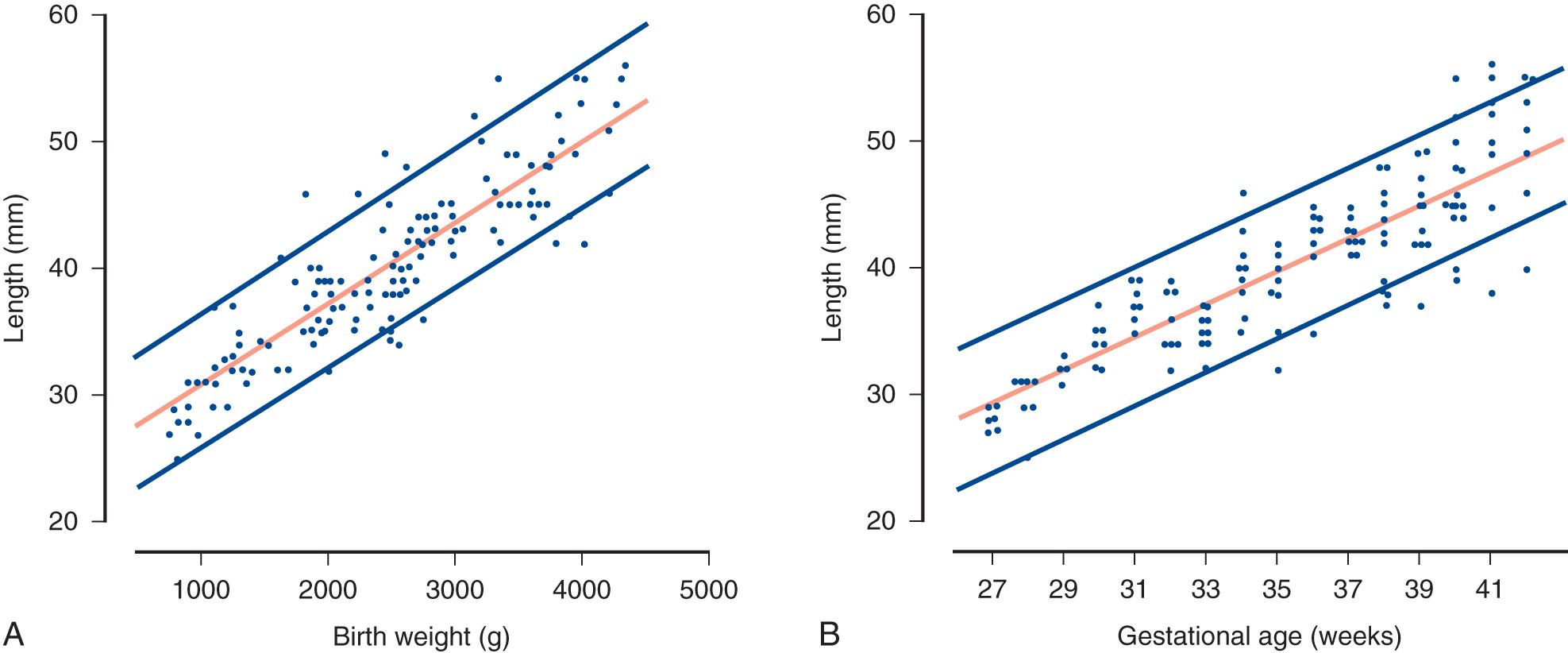
Doppler ultrasound of the kidneys is performed in select patients when renal arterial or venous disease is suspected, using techniques similar to those employed in adults (see Renal Vascular Disease below).
Longitudinal and transverse views of the urinary bladder are obtained in both distended and postvoid states. Images are obtained with a convex linear transducer using the highest frequency that will penetrate the patient. Harmonic imaging may be useful to minimize artifacts. Bladder volume may be determined on longitudinal and transverse views of the urinary bladder when maximally but comfortably distended ( Fig. 52.4 ). Because the bladder varies in shape, various formulas have been suggested to calculate its volume. The most commonly used method calculates bladder volume using the formula for determining the volume of a prolate ellipsoid, noted earlier.
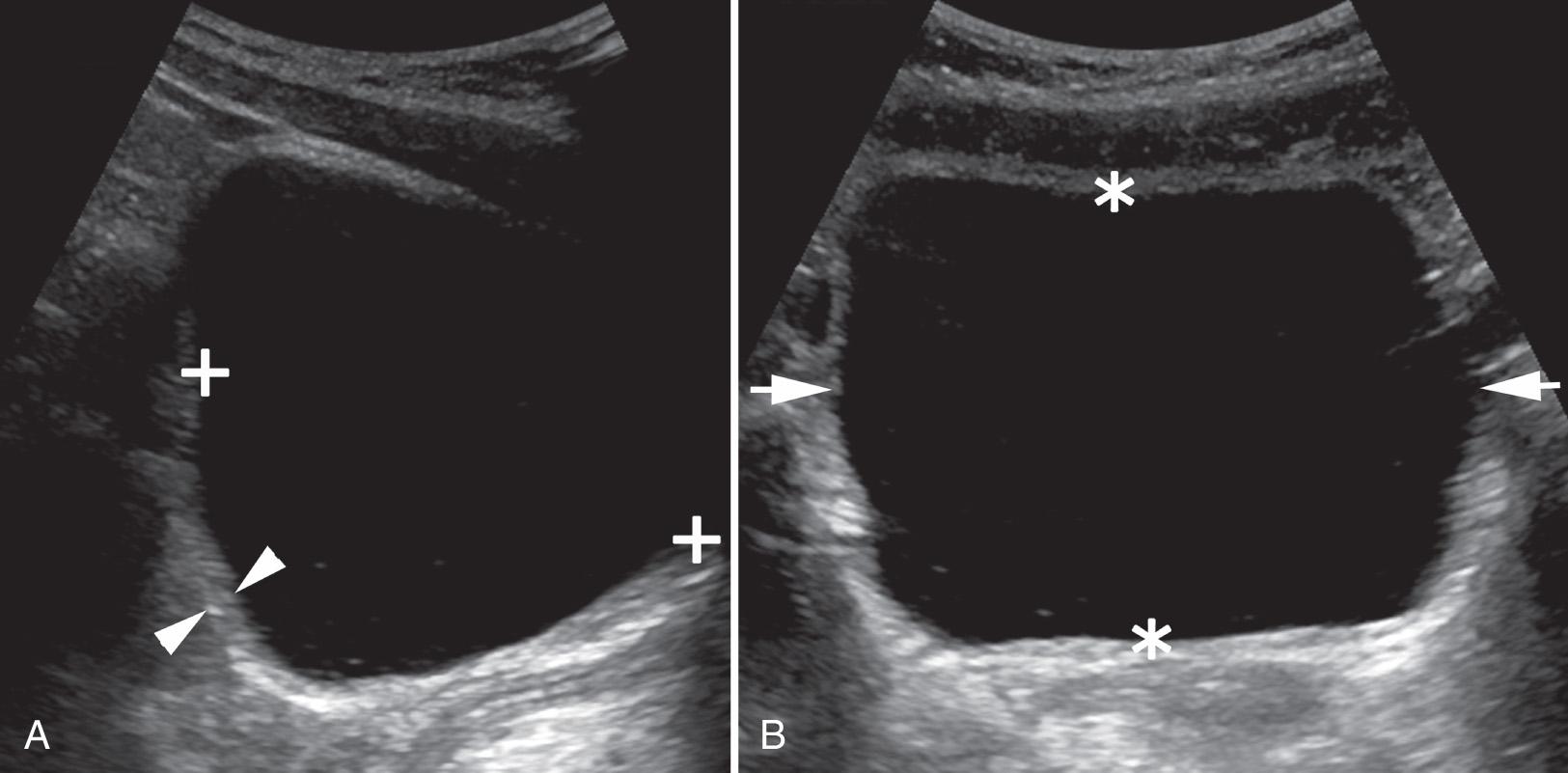
Bladder wall thickness in children has been evaluated in only a few studies using different techniques and leading to somewhat different results and conclusions. A retrospective study by Jequier and Rousseau measured the wall posterolateral to the trigone on transverse or sagittal images in 410 children and 10 adults whose bladders were filled to a variable degree. They determined that the normal mean wall thickness is 2.8 mm when the bladder is almost empty, and 1.5 mm when it is distended. There was a linear relationship between bladder fullness and wall thickness, with upper limits of 3 mm and 5 mm for a full or empty bladder, respectively. In a more recent prospective study of children with full bladders by Uluocak and colleagues, thickness measurements were obtained from the anterior, posterior, and lateral walls. Mean anterior, posterior, and lateral wall thicknesses were 1.4 mm (range 0.8-2.8), 1.6 mm (range 0.7-3.1), and 1.5 mm (range 0.6-2.6), respectively. Strong positive correlations were found between anterior and posterior wall thickness and increased age and body mass index (BMI). However, in contrast to the study of Jequier and Rousseau, there was no correlation between bladder volume and anterior or posterior wall thickness. Further studies are required in order to better delineate the effects of measurement technique as well as patient age, height, and BMI on bladder wall thickness.
Scans of the bladder are best performed with the bladder comfortably full so that abnormalities, including wall thickening and trabeculation, can be seen. Dilation of the distal ureters and ureteroceles is also sought. The thickness of the bladder wall may be increased with inflammation or muscular hypertrophy. Postvoid views of the bladder and kidneys may be helpful in patients with a neurogenic bladder or dilated upper collecting system, because a distended bladder may cause increased dilation but improve after voiding.
Color Doppler sonography is used in selected clinical situations to evaluate the ureteral jets ( Fig. 52.5 ).
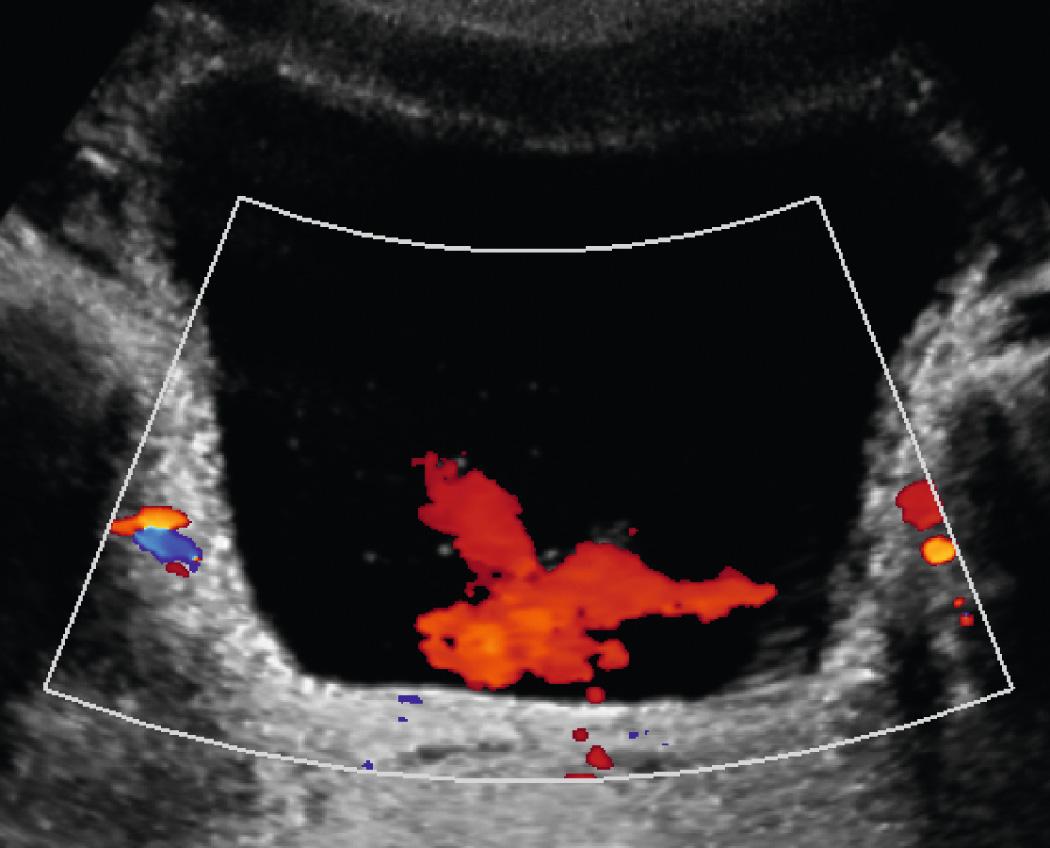
Throughout the second trimester, the fetal kidney consists of a collection of renunculi (small kidneys), each composed of a central large pyramid with a thin peripheral rim of cortex. As the renunculi progressively fuse, their adjoining cortices form a column of Bertin. The former renunculi are then called “lobes.” Remnants of these lobes with incomplete fusion are recognized by a lobulated surface of the kidney. This “persistent fetal lobulation” ( Fig. 52.6 ) should not be confused with renal scarring and may persist into adulthood. Fetal lobulation is distinguished from scarring by the presence of a smooth renal contour, regular spacing, and absence of calyceal blunting. The indentations spare the renal pyramids, unlike scarring, in which the renal parenchyma overlying the pyramids appears thinned.
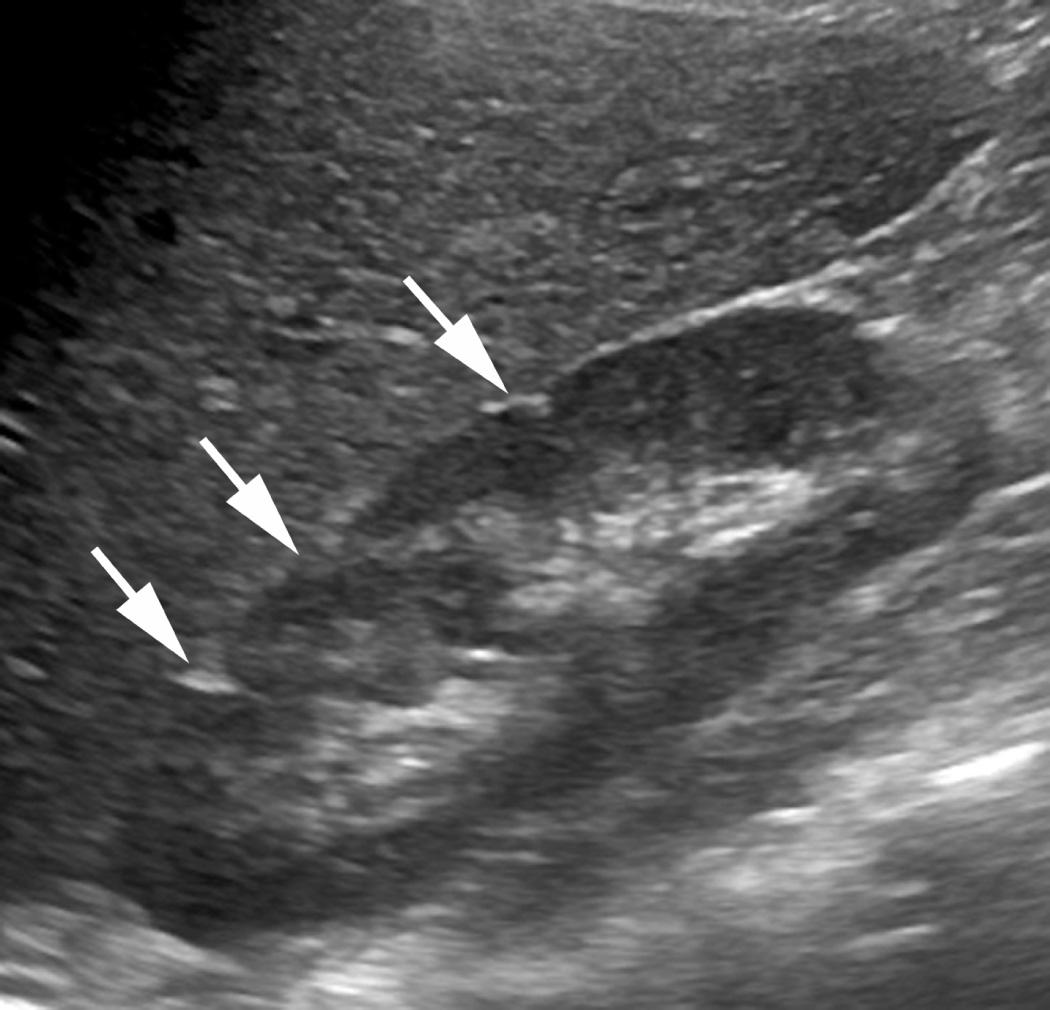
The renal junctional parenchymal defect (interrenicular septum or fissure) is the most prominent of these grooves, extending from the hilum to the cortex, and is caused by perirenal fat adherent to the renal capsule along a cleft on the renal surface. It is frequently seen in the anterosuperior aspect of the kidney ( Fig. 52.7 ). At birth, the pyramids are still large and hypoechoic compared with the thin rim of echogenic cortex that surrounds them. Glomerular filtration rate shortly after birth is low and increases rapidly after the first week postpartum. Throughout childhood, there is significant growth of the cortex, and the pyramids gradually become proportionately smaller.
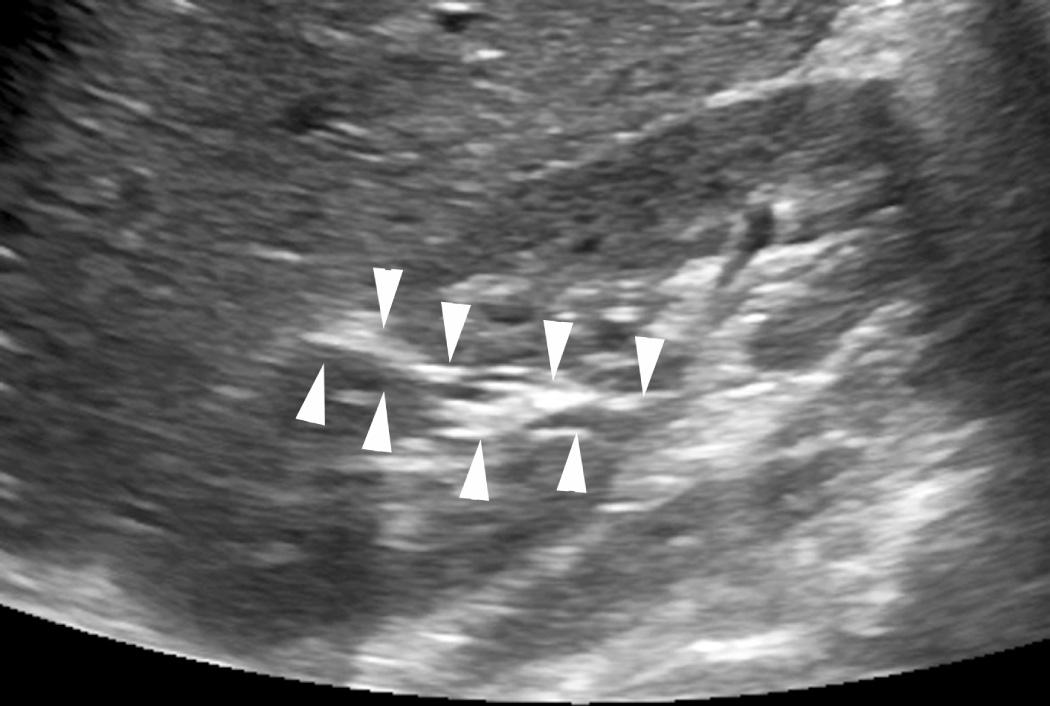
The anatomy and sonographic appearance of the pediatric kidney depend on age. The normal infant kidney has several features that differ from the normal adult kidney ( Fig. 52.8 ). The central echo complex is much less prominent compared with the renal parenchyma because there is less peripelvic fat in the infant than in the adult. Renal cortical echogenicity is typically increased in the normal premature infant kidney compared with the liver and spleen. The echogenicity of the renal cortex in the normal term infant kidney is often the same as the echogenicity of the adjacent normal liver, whereas in the older child and adult kidney, the renal cortex is less echogenic than the liver. The medullary pyramids in the infant are relatively larger and tend to appear more prominent (more hypoechoic). The corticomedullary differentiation is greater in the infant and child's kidney than in the adult, possibly because of increased resolution from higher frequency transducers and less overlying body fat tissue. It may also result from differences in the cellular composition of the renal parenchyma in the infant. These prominent pyramids in the pediatric kidney can easily be mistaken for multiple cysts or dilated calyces by those not familiar with the differences. Normal pyramids line up around the central echo complex in a characteristic pattern and can therefore be differentiated from cysts. The position of the arcuate artery at the corticomedullary junction can also help to identify a structure as a pyramid.
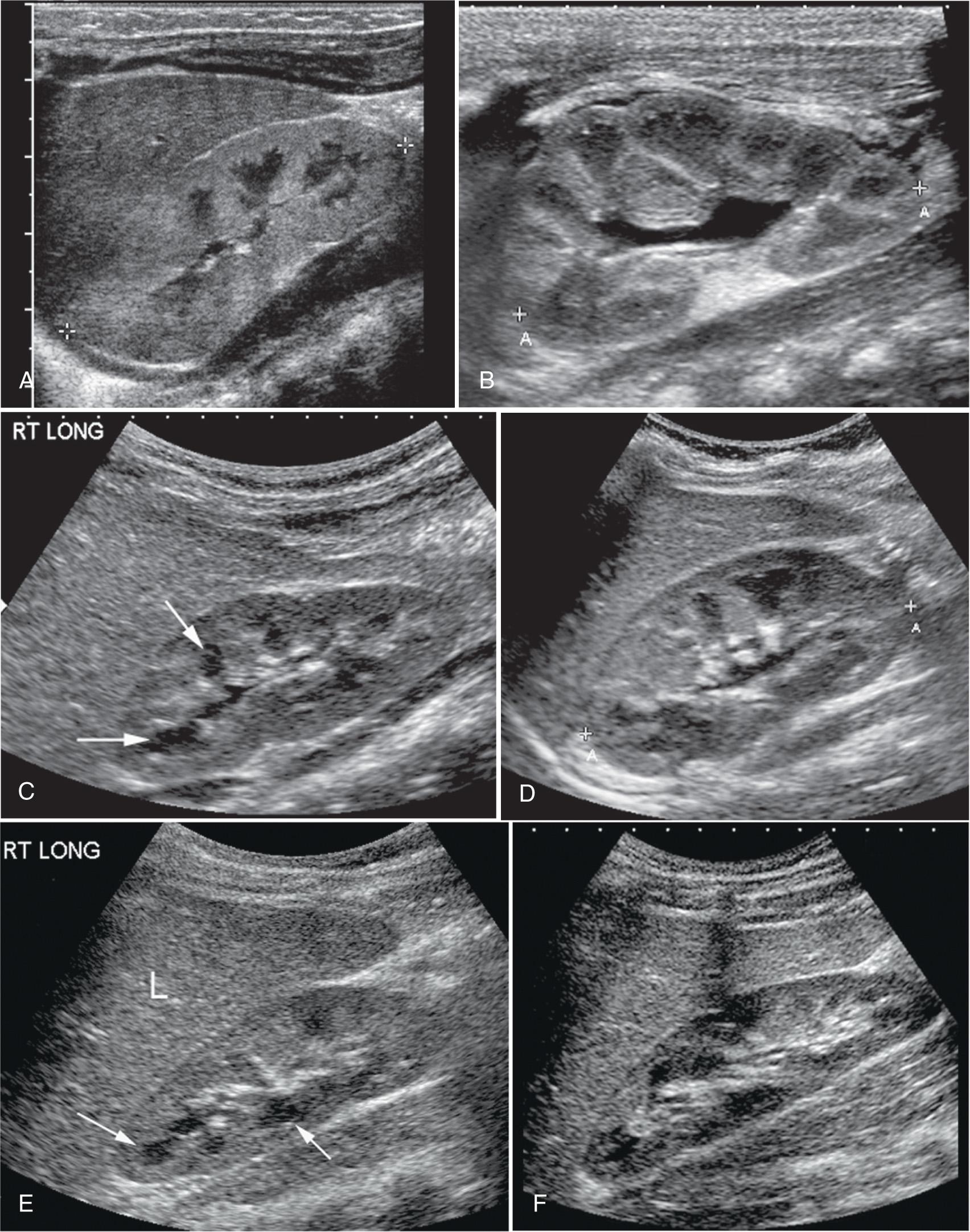
Renal anatomy in the teenager and older child is similar to that in the adult (see Fig. 52.8 ). The renal parenchyma consists of the cortex, which is peripheral, contains the glomeruli, and has several extensions to the edge of the renal sinus (the septa or column of Bertin); and the medulla (containing the renal pyramids), which is more central and adjacent to the calyces. The normal cortex produces low-level, backscattered echoes. The medullary pyramids are relatively hypoechoic and arranged around the central, echo-producing renal sinus. The arcuate vessels can be demonstrated as intense specular echoes at the corticomedullary junction. This corticomedullary differentiation can be identified in most children but occasionally cannot be visualized in those with increased overlying soft tissues. The central echo complex consists of strong specular echoes from the renal sinus, including the renal collecting system, calyces and infundibula, arteries, veins, lymphatics, peripelvic fat, and part of the renal pelvis. With distention of the renal collecting system, these echoes become separated and small degrees of hydronephrosis can be demonstrated. Mild degrees of distention can be seen in normal children, particularly after recent high intake of fluids or diuretics. A normally distended urinary bladder can also cause functional ureteral obstruction and mild distention of the renal collecting systems. Rescanning when the bladder is empty will usually result in resolution of both collecting system and ureteral distention in an otherwise normal urinary tract.
The normal urinary bladder is thin walled. Bladder volume and wall thickness are influenced by the degree of bladder distention. The distal ureters may be visible at the bladder base, especially if the child is well hydrated, likely related to the normal transient passage of urine associated with peristalsis ( Fig. 52.9 ). Bladder wall thickness may increase with inflammation or muscular hypertrophy.
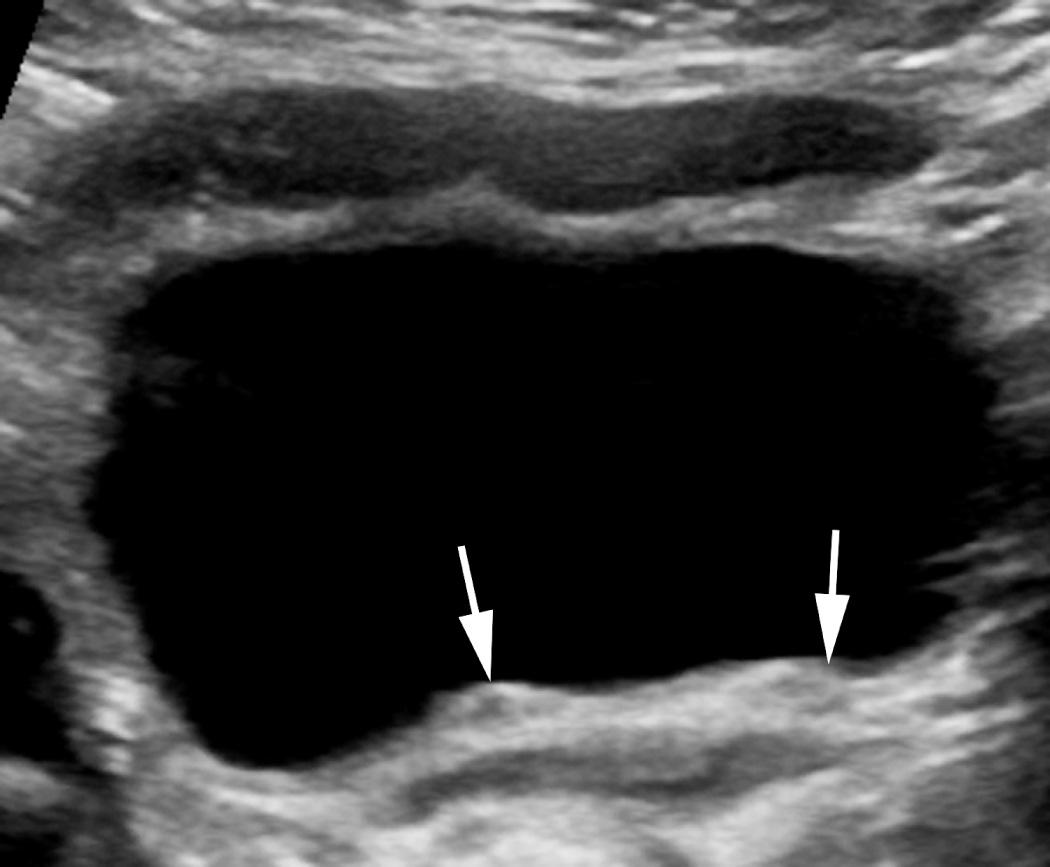
A common congenital anomaly of the urinary tract is duplication of the collecting system, which may be partial or complete. In complete duplication, two pelves and two separate ureters drain the kidney. The lower-pole ureter usually inserts into the bladder at the normal site. However, the intramural portion of the ureter may be shorter than usual, and vesicoureteral reflux (VUR) frequently results. The upper-pole ureter often inserts ectopically, inferior and medial to the site of the normal ureteral insertion (Weigert-Meyer rule). Its orifice may be stenotic and obstructed. Ballooning of the submucosal portion of this upper-pole ureter causes a ureterocele. In some patients, the upper-pole ureter may have an insertion entirely outside the bladder including the urethra (above, at, or below the external urinary sphincter), in the uterus or vagina, or in the ejaculatory duct, seminal vesicle, or vas deferens.
Patients with unobstructed duplications have no more clinical problems than their normal counterparts. Patients with complicated renal duplications may have UTI, failure to thrive, abdominal mass, hematuria, or symptoms of bladder outlet obstruction from a ureterocele. Female patients with urethral insertion of the upper-pole ureter below the external urinary sphincter or with vaginal or uterine insertion may have chronic, constant urinary incontinence or frequent dribbling.
Duplication of the renal collecting system is diagnosed on sonography when the central echo complex separates into two parts with an interposed column of normal renal parenchyma (column of Bertin) ( Fig. 52.10 ). Unless collecting system dilation and/or ureteral dilation are present, it is usually impossible to distinguish a partial, uncomplicated duplication from a complete duplication because a normal ureter is difficult to visualize sonographically.
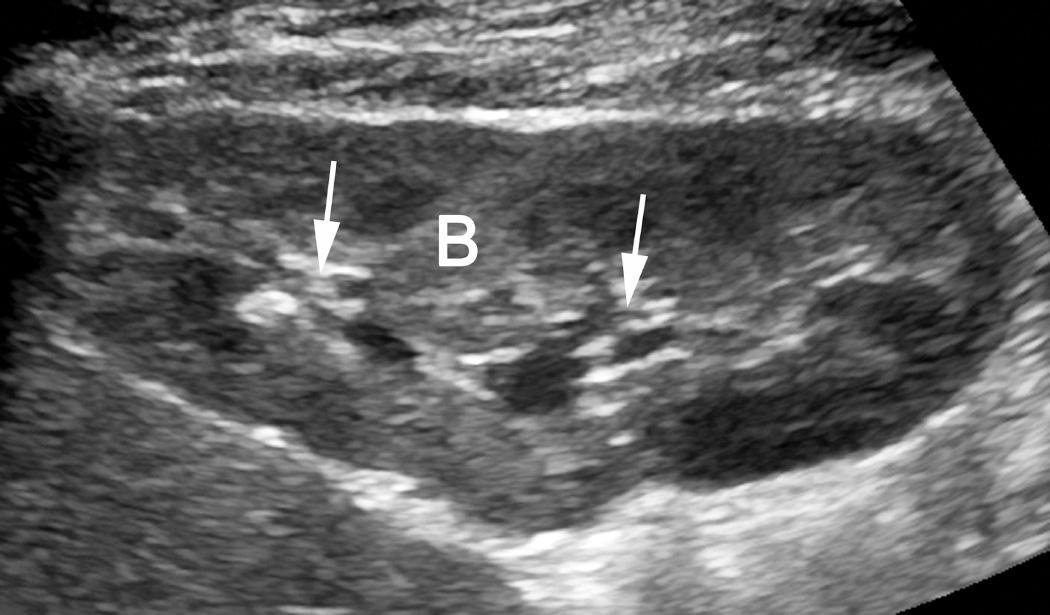
With obstruction of an upper-pole moiety, dilation of the upper-pole collecting system and its entire ureter is seen. The renal parenchyma may be thinned over the upper-pole collecting system. If the obstruction is associated with a ureterocele, views of the bladder may demonstrate the ureterocele as a rounded, anechoic structure within the bladder in addition to the dilated distal ureter adjacent to the bladder ( Fig. 52.11 ). A large ureterocele may cross the midline and obstruct the contralateral ureter or bladder outlet and cause bilateral hydronephrosis. Ureteroceles can be difficult to diagnose if they are large enough to mimic the bladder. If this is a concern, a postvoid scan will be diagnostic. With reflux into the lower-pole moiety, the lower-pole collecting system and its ureter will be dilated to a varying degree. If reflux is mild, there may be no lower-pole dilation.

Other renal anomalies include congenital absence of the kidney, abnormal position of the kidney (e.g., pelvic kidney, crossed ectopia), and horseshoe kidney with fusion of the lower poles in the midline. Congenital absence of the kidney or ectopia of the kidney is suspected when no renal tissue can be identified in the renal fossa on sonography. At birth, the adrenal gland will not present as the usual inverted V above the kidney but assumes a flat shape often called a “lying-down adrenal” ( Fig. 52.12 ). Care must be taken to search for the kidney not only in its usual location in the renal fossa, but also in the lower abdomen or pelvis. The contralateral kidney, when healthy, shows compensatory hypertrophy when one kidney is absent or severely damaged. Nuclear scintigraphy may be helpful in identifying a small, functioning kidney not visualized by ultrasound.
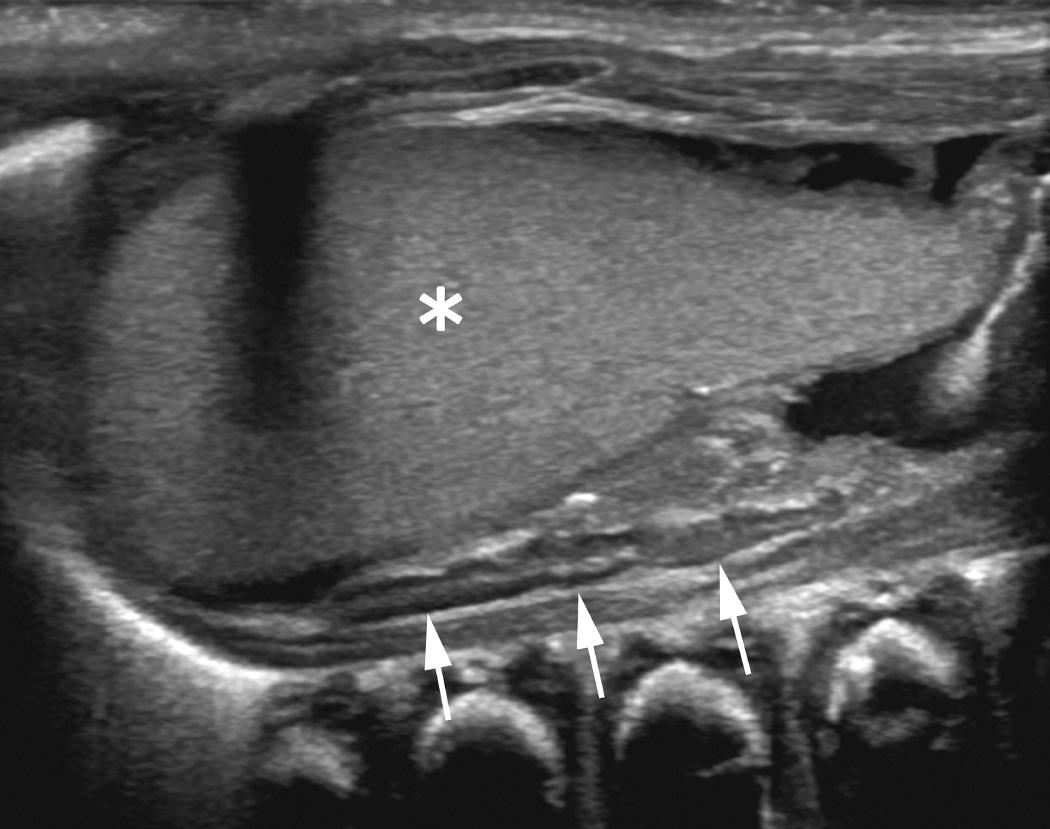
With a horseshoe kidney the longitudinal axis of the kidneys is abnormal. The lower poles are rotated medially and will be fused in the midline anterior to the spine by a fibrous band or renal parenchyma ( Fig. 52.13 ). The kidney is also positioned somewhat lower than usual. A horseshoe kidney can be overlooked if the abnormal renal axes are not recognized. The central fused renal tissue may also be thin and easily missed, particularly if it solely fibrous in nature.
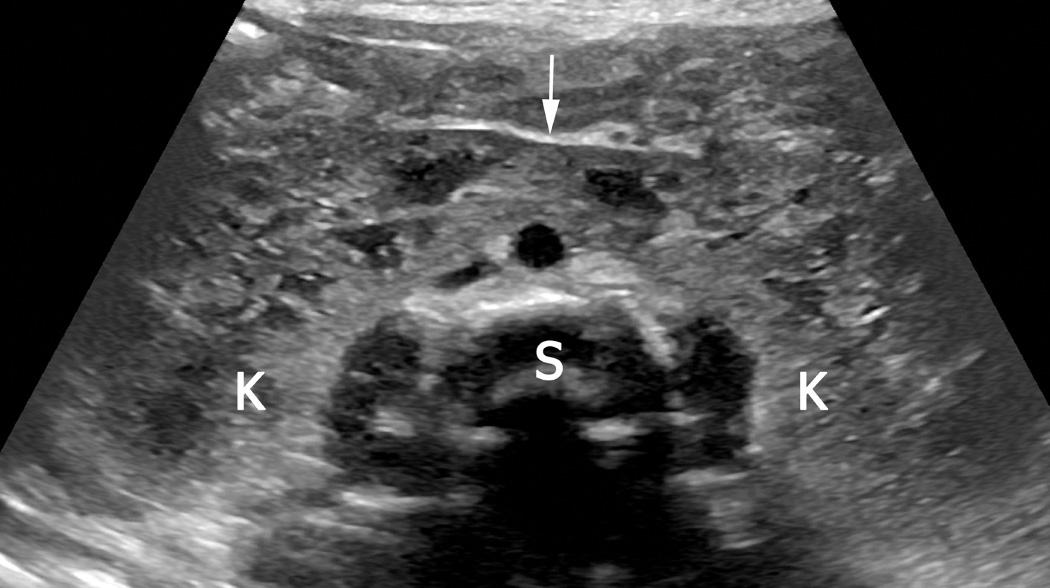
Crossed renal ectopia is a rare congenital anomaly wherein both kidneys are located on the same side of the abdomen. There is at least some degree of fusion in approximately 90% of cases, with the usual pattern consisting of fusion of the orthotopic lower renal pole to the ectopic upper renal pole ( Fig. 52.14 , ). The ureter of the ectopic kidney crosses the midline to insert normally within the bladder. Crossed renal ectopia is more frequent in boys than girls (male-to-female ratio is 1.4 : 1), and is two to three times more common on the right side than on the left. As with other renal anomalies, crossed ectopia can be an incidental finding but is also associated with other congenital anomalies.
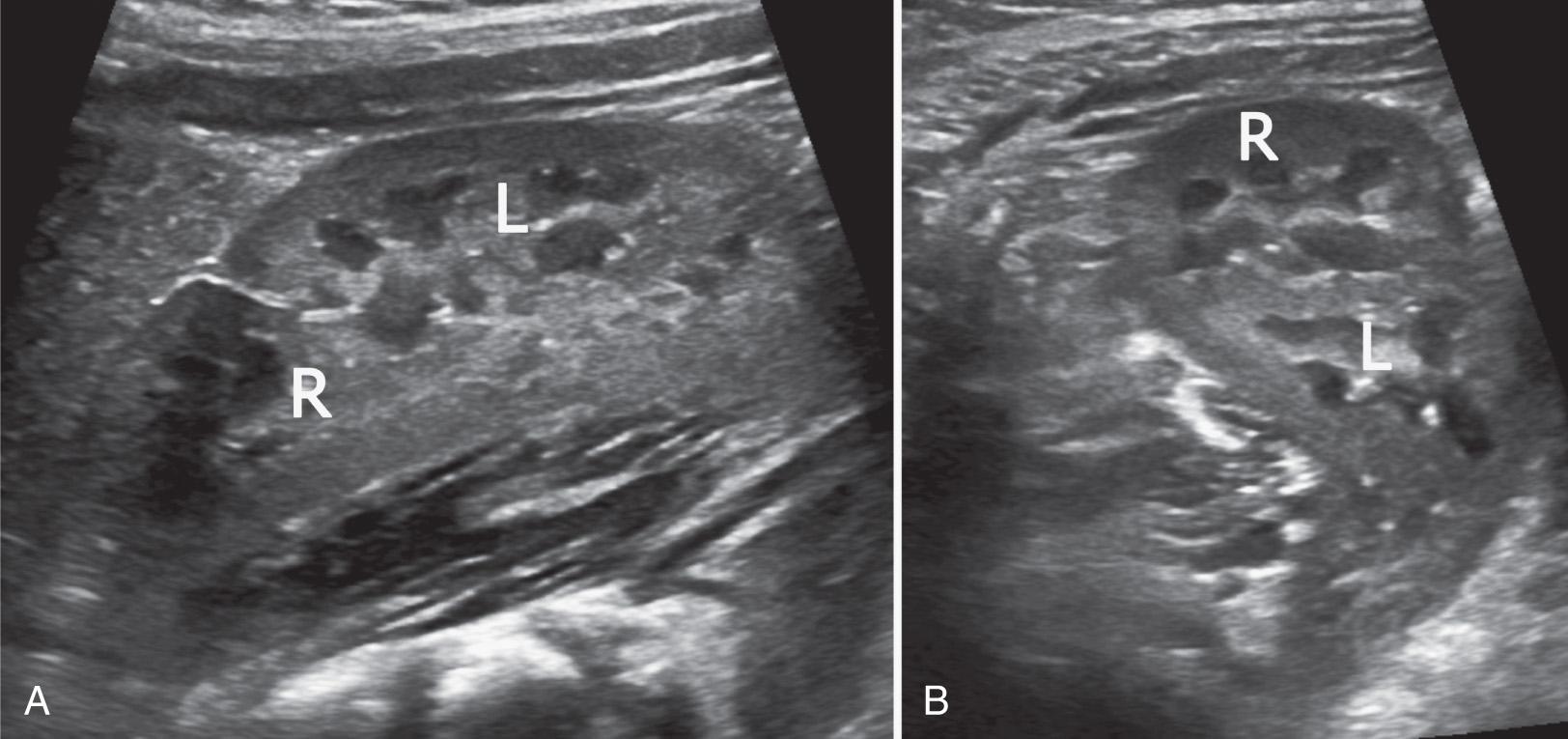
Rarer patterns include crossed unfused ectopia and solitary or unfused bilateral crossed ectopy. Another pattern of combined ectopy and fusion of two pelvic kidneys is variably referred to as a “pancake” or “cake” kidney, depending on the extent of fusion and the resultant appearance. These more complex abnormalities can be isolated or associated with other congenital conditions.
Dilation of the renal collecting system—hydronephrosis—is a fairly common problem in the pediatric patient. It is frequently, but not always, associated with obstruction, and ultrasound is particularly sensitive for its detection. Investigation of a child with suspected hydronephrosis usually begins with sonography to evaluate the anatomy of the kidneys, ureters, and bladder. The degree of functional obstruction is evaluated by diuretic renography. If the obstruction is mild, the patient is followed because the obstruction and dilation often resolve as the patient grows older.
Congenital hydronephrosis is almost always initially detected on fetal sonography and the infant referred for evaluation after birth. Fetal hydronephrosis may be due to obstruction, VUR, or a physiologic variant without obstruction. Small amounts of fluid may be detected in the normal renal pelvis. However, dilation of the renal calyces is abnormal and suggests significant pathology. To make a more precise diagnosis and to estimate severity, information regarding renal length, parenchymal thickness and echogenicity, degree of pelvicalyceal and ureteral dilation, bladder wall thickness, and volume should be obtained with sonography. Voiding cystourethrography (VCUG) and nuclear scintigraphy using technetium 99m ( 99m Tc) mercaptoacetyltriglycine (MAG3) with furosemide (diuretic renography) are often performed for complete evaluation.
Significant variation currently exists in the clinical management of infants and children with prenatally diagnosed urinary tract dilation (UTD) that is related to a lack of evidence-based information correlating the severity of prenatal dilation to postnatal urologic abnormalities. To address the perceived need for a unified classification system with a widely accepted terminology for the diagnosis and management of prenatal and postnatal UTD, a UTD classification system was devised in 2014 during a consensus meeting of eight medical societies concerned with the prenatal and postnatal diagnosis and management of UTD. This grading system is correlated with the risk of postnatal uropathies and is based on six sonographic features: (1) anterior-posterior renal pelvic diameter (APRPD), (2) calyceal dilation with distinction between central and peripheral calyceal dilation postnatally, (3) renal parenchymal thickness, (4) renal parenchymal appearance, (5) bladder abnormalities, and (6) ureteral abnormalities. For prenatal studies, the seventh sonographic finding to report is the quantity of amniotic fluid. Normal imaging parameters are also defined ( Figs. 52.15 and 52.16 ). It is anticipated that future research will result in a refinement of this classification system that can be correlated with other clinical outcomes such as renal function and the need for surgical intervention.
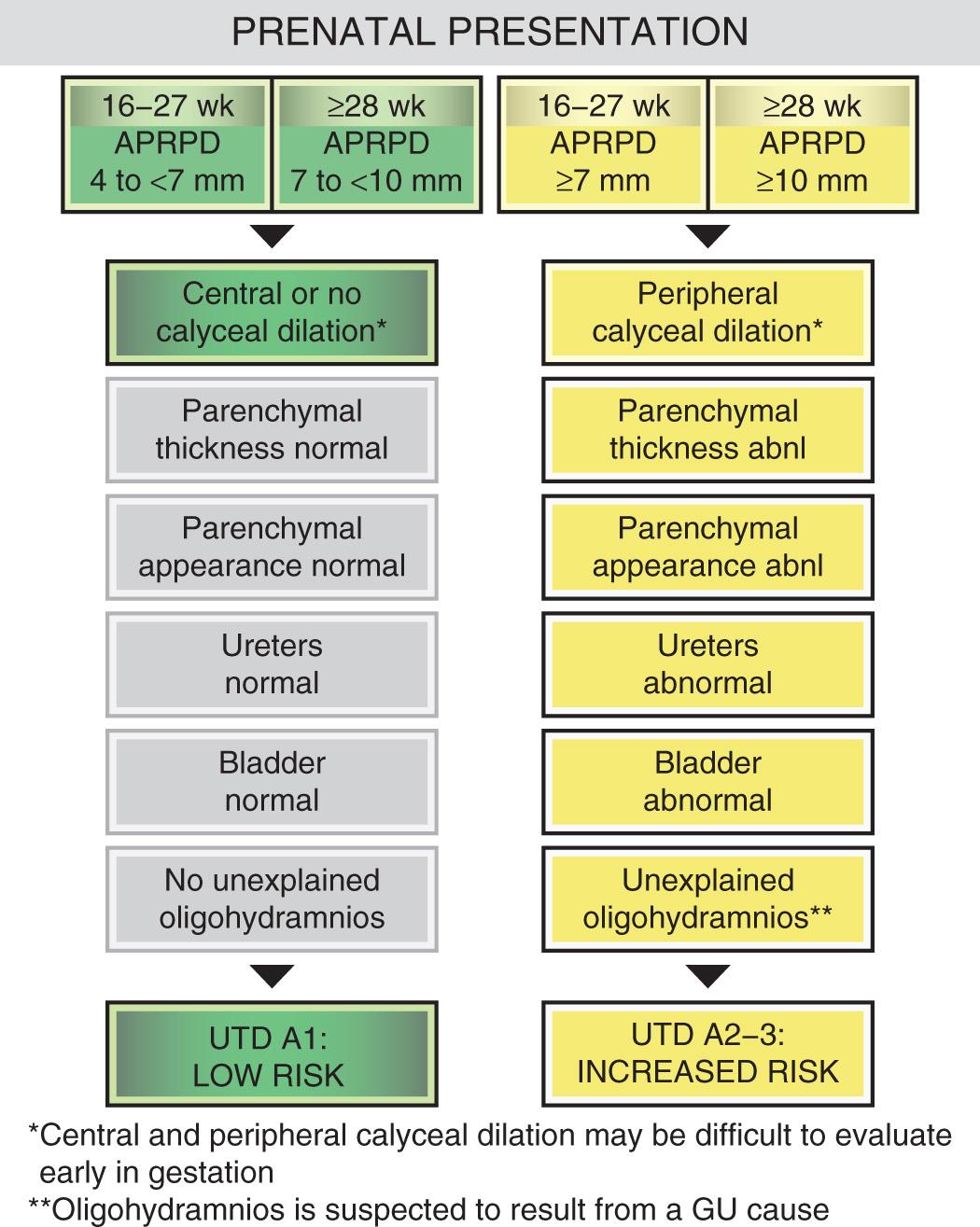
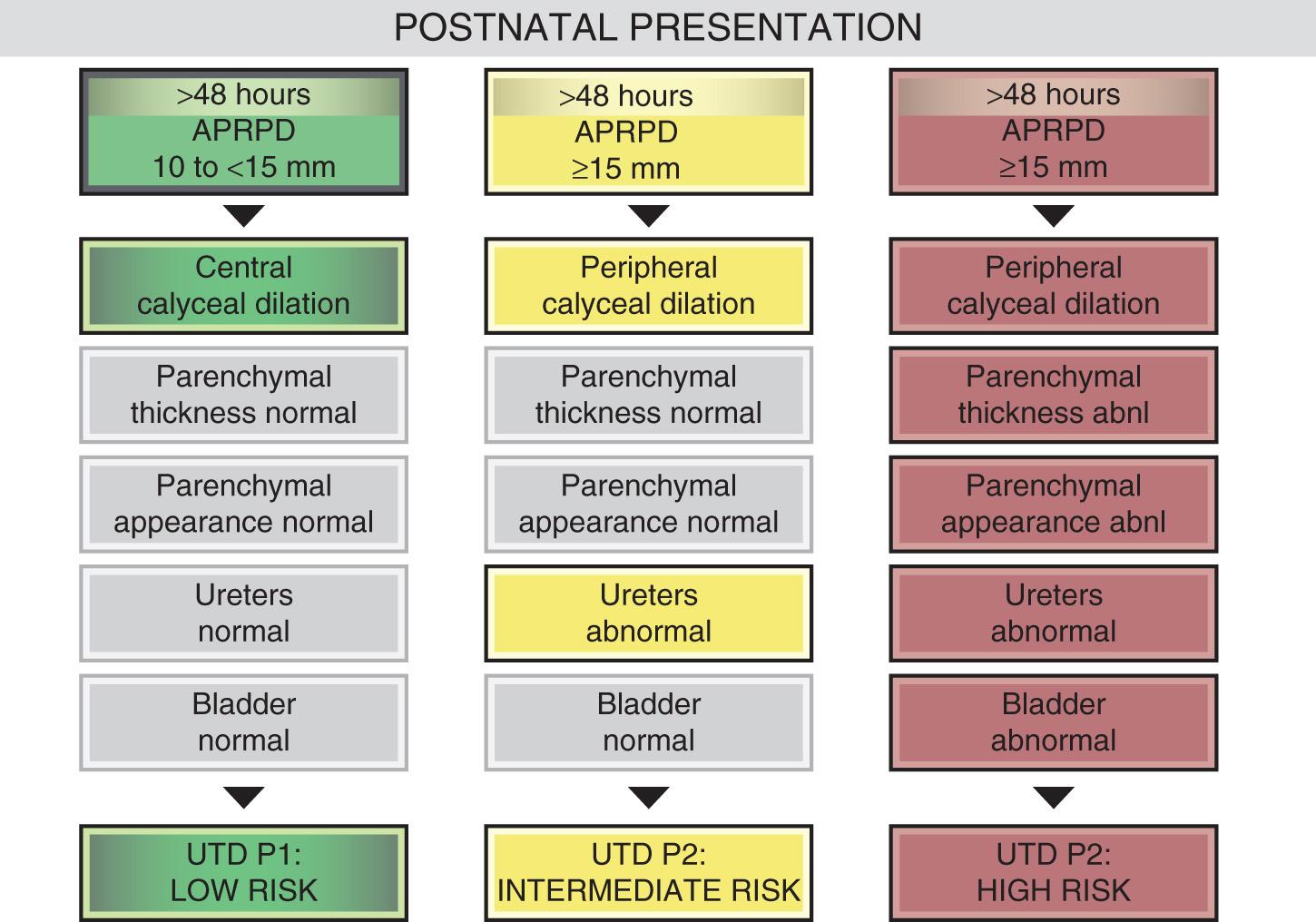
Ureteropelvic junction obstruction (UPJO) is the most common cause of significant prenatal hydronephrosis. It is usually results from a functional stricture at the ureteropelvic junction (UPJ) or a crossing lower-pole renal vessel. UPJO results in a functional disturbance in either the initiation or the propagation of normal peristaltic activity within the ureter. The obstruction produces proximal dilation of the renal collecting system. There is also an associated increased incidence of congenital anomalies of the contralateral kidney.
Ultrasound diagnosis of hydronephrosis is based on the presence of a dilated renal pelvis and caliectasis. A variable amount of renal parenchymal tissue can be visualized. The ureter is normal in size and is not usually visualized by ultrasound ( Fig. 52.17 ).
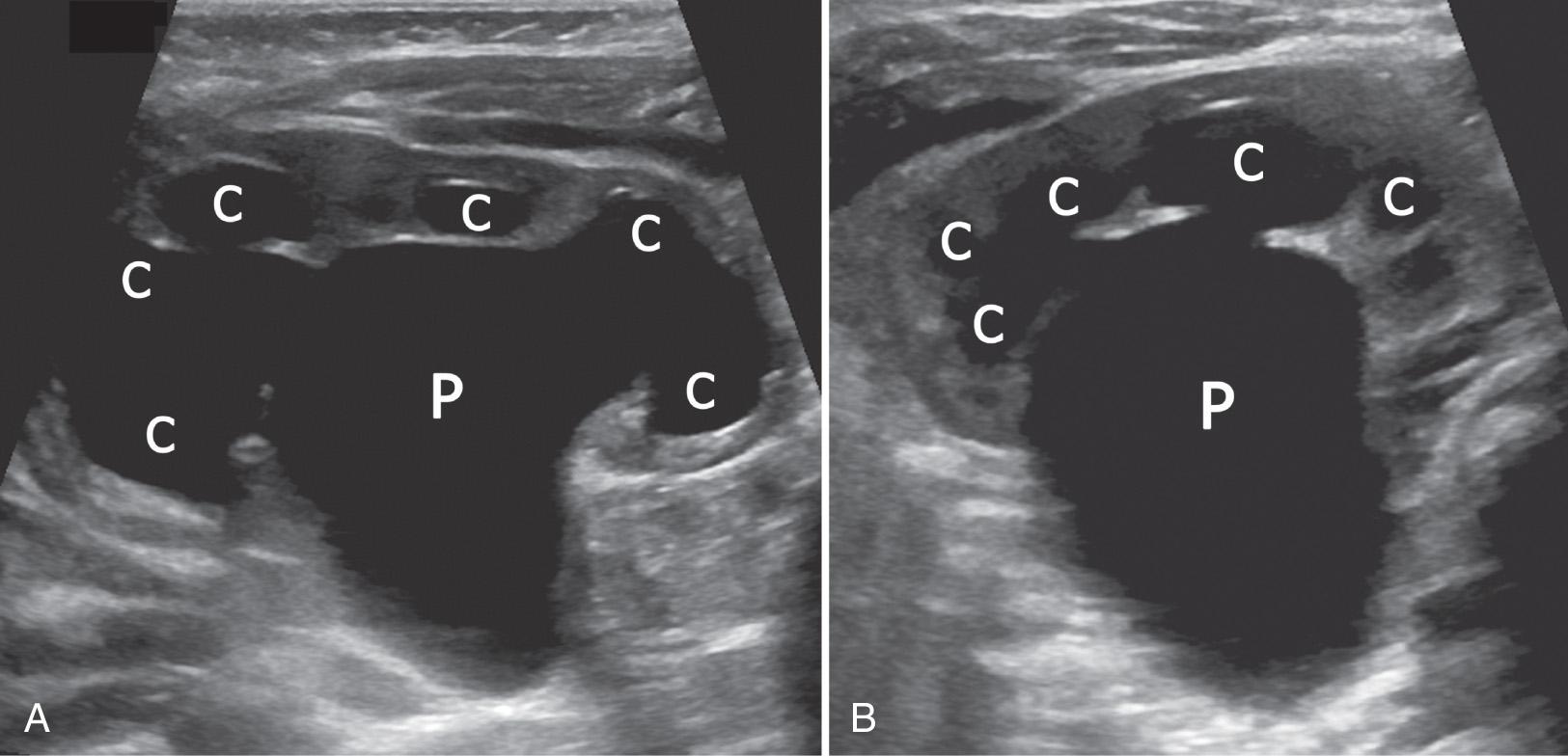
Congenital ureterovesical junction obstruction (UVJO) is a result of narrowing and aperistalsis of the distal ureter, or an ectopic insertion. With so-called “primary megaureter” the juxtavesicular ureter may be devoid of ganglion cells or may demonstrate muscular hypoplasia and/or mural fibrosis. The submucosal tunnel and ureteral orifice are normal. There is a variable degree of dilation of the intrarenal collecting system and of the ureter proximal to the narrowing. Ultrasound typically shows hydronephrosis and hydroureter with a narrow segment of the distal ureter behind the bladder ( Fig. 52.18 ). MAG3 diuretic renography is typically used to clarify whether the dilation is caused by obstruction.
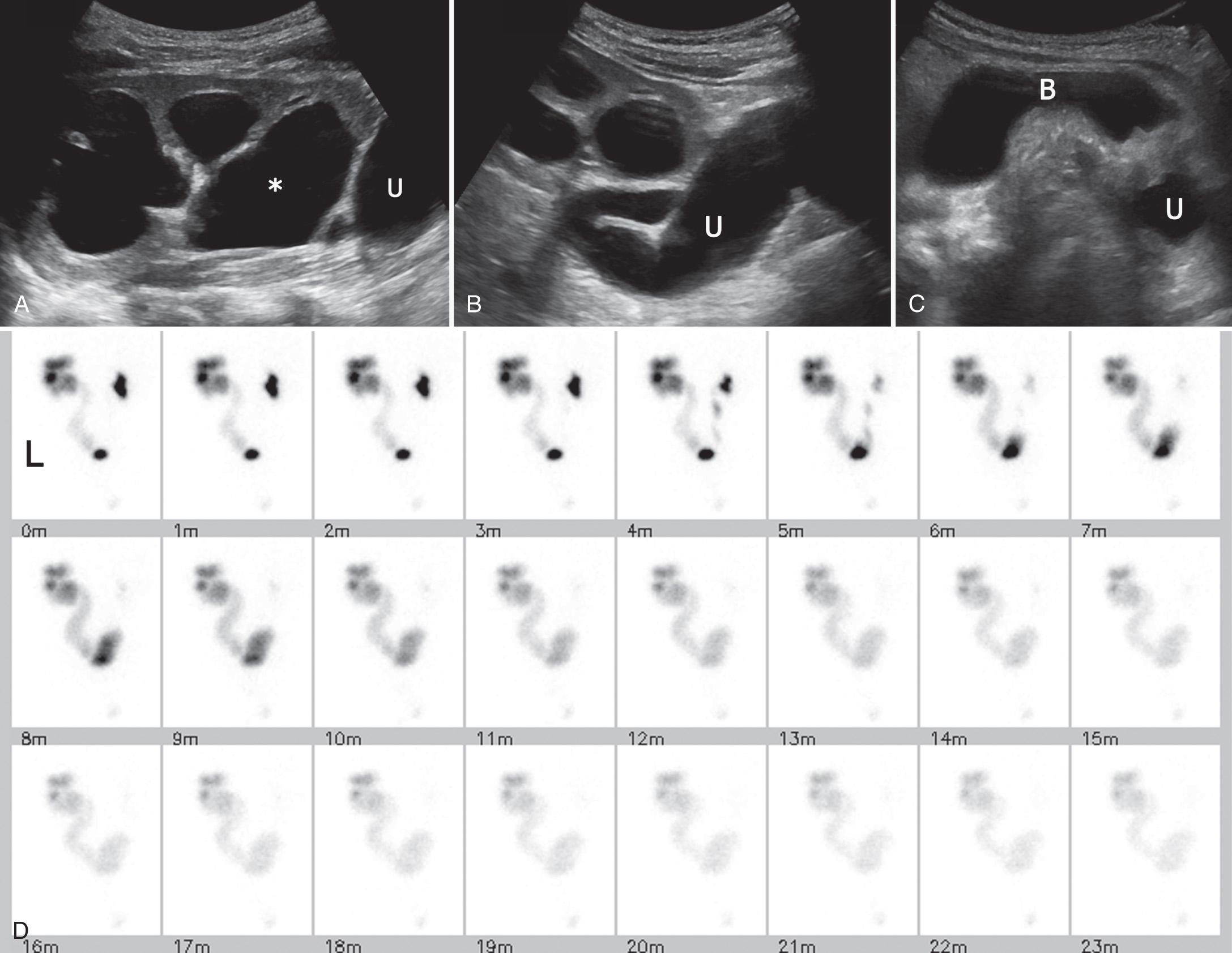
An obstructed ureter can result from many causes. Ectopic insertion of a ureter can cause obstruction either with or without a ureterocele and may result in dilation of the more proximal collecting system and ureter, typically manifesting with ureteral duplication. The ureter can also be obstructed by an intraluminal abnormality, such as a stone, blood clot, or fungus ball. Increased peristalsis in the ureter proximal to the obstruction may be detected with real-time sonography. Doppler sonography may show a diminished or abnormal ureteral jet on the side of obstruction. The ureter can also be obstructed anywhere along its course by extrinsic compression from a mass, such as a lymphoma or abscess. The exact site of obstruction may be difficult to visualize by ultrasound because of overlying bowel gas.
Bilateral hydronephrosis is frequently caused by obstruction at the level of the bladder or bladder outlet. Congenital obstruction due to posterior urethral valves (PUVs) results in an irregular, thick-walled bladder. PUV can occasionally be diagnosed by ultrasound, with demonstration of a dilated posterior urethra. Transperineal contrast-enhanced ultrasound (CEUS) diagnosis of PUV has also been described ( Fig. 52.19 ). However, VCUG should be performed for optimal visualization of the valves.
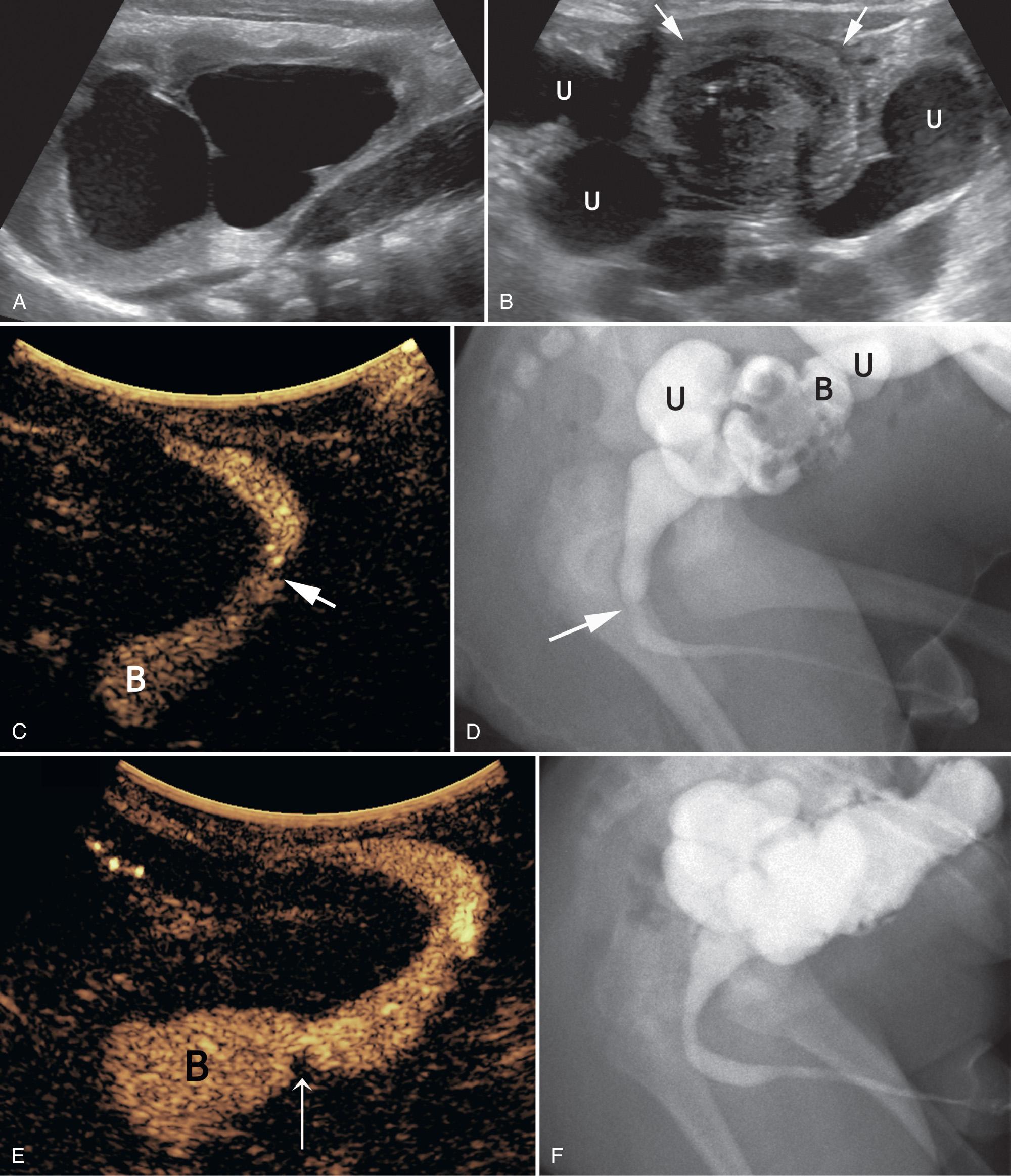
Patients with spinal dysraphism and hyperreflexive detrusor muscle activity will have a functional obstruction due to a neurogenic bladder that produces high bladder pressure during voiding. These patients may develop a thick-walled, trabeculated bladder ( Fig. 52.20 , , , ). Congenital anomalies of the spine should be sought with radiographs and spinal ultrasound in neonates, if not obvious clinically.
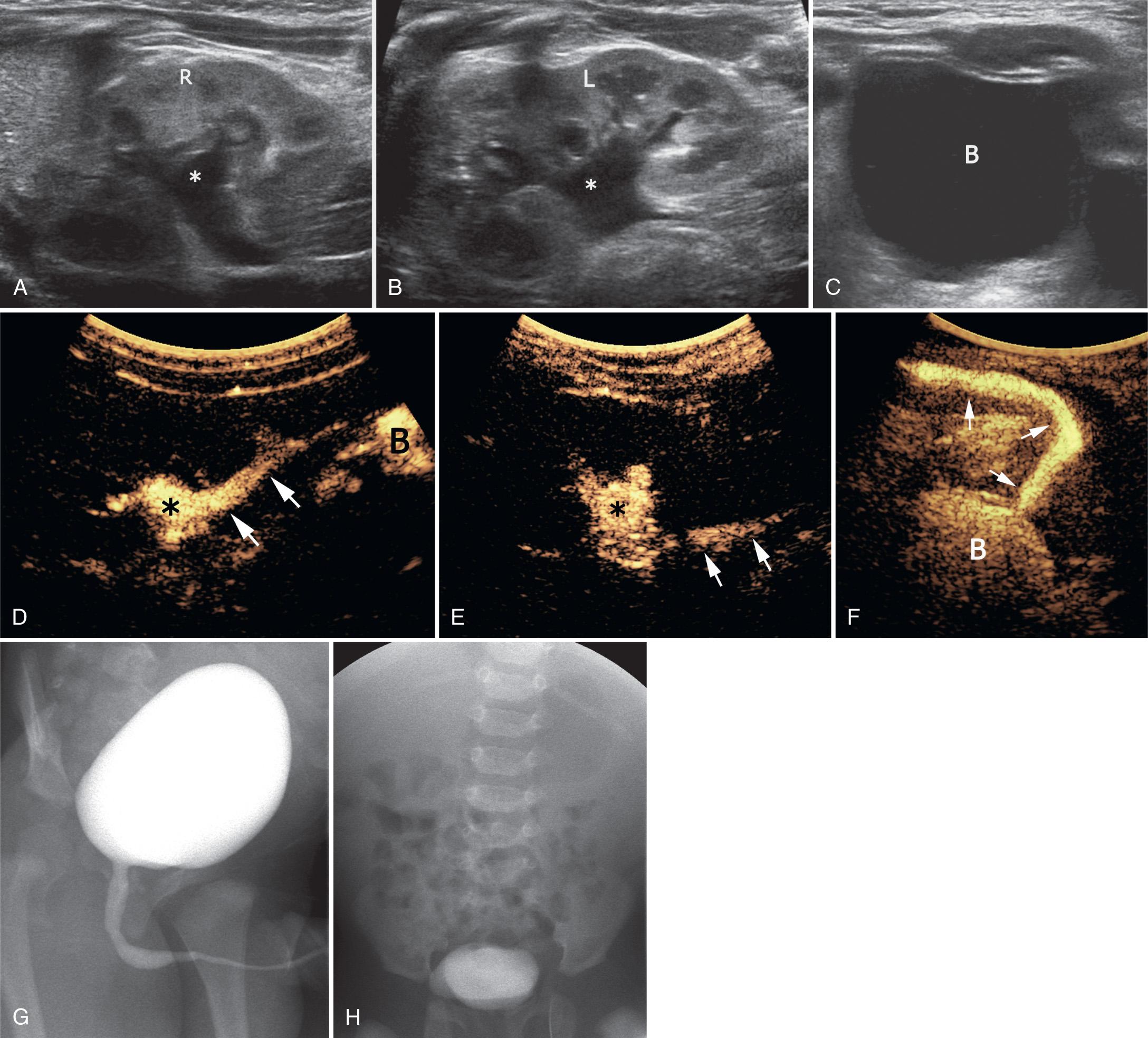
A pelvic mass that obstructs the bladder outlet, such as rhabdomyosarcoma, or less commonly, a fibroepithelial polyp, can also be associated with bilateral hydronephrosis and hydroureter.
Dilation of the renal collecting system is not always caused by obstruction, and other abnormalities, such as VUR, should be considered. In a child with hydronephrosis detected by ultrasound, the bladder size and contractility and the urethra should be further evaluated with VCUG. In addition, VUR can be diagnosed and may be the cause of the UTD.
Contrast-enhanced voiding urosonography is a safe, nonionizing, radiation-free alternative to the fluoroscopic VCUG that is used by experienced investigators in some centers throughout the world for the management of VUR. Its sensitivity is comparable to or greater than that of VCUG or radionuclide cystography in the diagnosis of VUR. Published studies reporting use of this technique in the United States to date have been limited. Contrast-enhanced voiding urosonography is performed after bladder catheterization and intravesical infusion of normal saline containing the ultrasound contrast agent. Sequential imaging of the bladder, kidneys, and urethra is performed during bladder filling and voiding. Ultrasound contrast-specific settings are used to image the microbubbles. Digital ultrasound still images as well as image clips are used for documentation purposes (see Fig. 52.20 ). The severity of VUR can be graded using a scale similar to the International Grading System used for conventional VCUG. Patients with reflux are often treated endoscopically with a submucosal, subureteric injection of a bulking agent. Follow-up sonography of the bladder will depict the implants, which over time may undergo changes in size and shape as well as calcification ( Fig. 52.21 ). Paltiel and colleagues showed that nonvisualization of the implant or a multilobed contour is associated with persistent reflux.
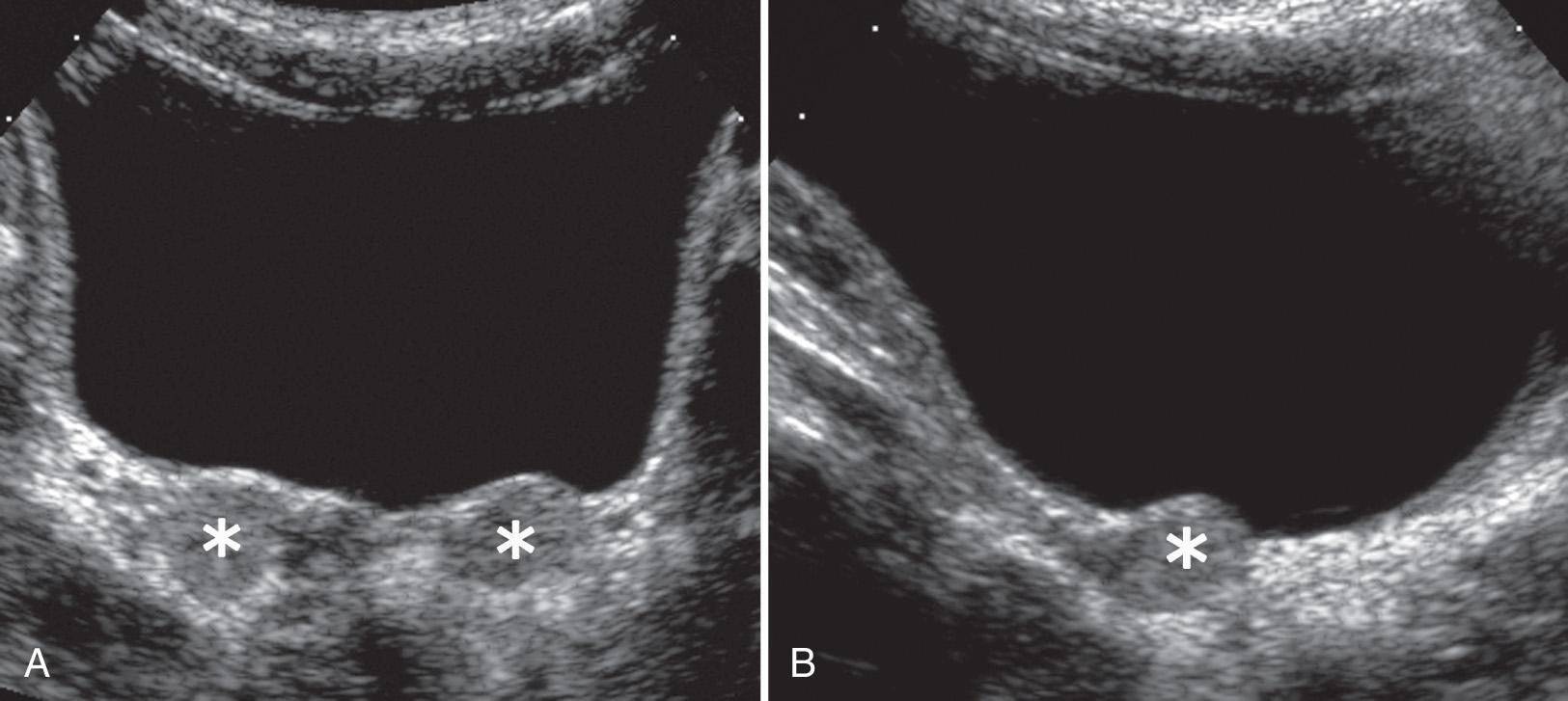
Prune-belly syndrome, also known as Eagle-Barrett syndrome, is a rare congenital disorder that occurs almost exclusively in males and is thought to result from urethral obstruction early in development. Abnormalities include absence or deficiency of the abdominal musculature; large, hypotonic, dilated and tortuous ureters; a large bladder; a patent urachus bilateral cryptorchidism; and a dilated prostatic urethra. There are decreased muscular fibers throughout the urinary tract and prostate, resulting in dilation and hypoperistalsis. Renal dysplasia and hydronephrosis can occur to varying degrees. Associated malformations of the cardiopulmonary, gastrointestinal, and skeletal systems are common.
Megacystis-microcolon-malrotation–intestinal hypoperistalsis syndrome (MMIHS), a rare syndrome, is an inherited, autosomal recessive disorder that falls on the spectrum of chronic intestinal pseudo-obstructive disorders, which includes chronic adynamic ileus, hypoganglionosis, Hirschsprung disease, intestinal neuronal dysplasia, and total colonic aganglionosis. It is more common in girls than boys. Presentation is usually in the neonatal period, although the diagnosis can also be suspected on prenatal sonography. Typical clinical features include abdominal distention, hypoactive or absent bowel sounds, and an inability to void spontaneously. A markedly dilated, nonobstructed bladder, a microcolon, and decreased or absent intestinal peristalsis are characteristic findings. Other frequent abnormalities include hydroureteronephrosis, VUR, intestinal malrotation, and a shortened bowel. Although the exact etiology has not yet been elucidated, smooth muscle myopathic changes have been demonstrated at pathology. Marked abnormality of the detrusor muscle of the bladder results in voiding dysfunction. Most patients with MMIHS eventually succumb to sepsis, malnutrition, or multiorgan failure. Recurrent UTIs result from the need for chronic bladder catheterization. Intestinal function is resistant to surgical intervention. Children who survive beyond the neonatal period require long-term total parenteral nutrition (TPN), which eventually results in TPN-associated chronic liver disease. Transplantation is currently the only successful management option for those patients who cannot tolerate TPN. The appropriate choice of transplant is dictated by the presence or absence of coexistent TPN-related chronic liver disease or chronic kidney failure resulting from urologic disease. These options include isolated intestinal transplantation, combined liver-intestinal transplantation, and multivisceral transplantation.
Bladder exstrophy is a rare congenital malformation characterized by an infraumbilical abdominal wall defect, incomplete bladder closure with mucosal continuity with the anterior abdominal wall, epispadias, and associated abnormalities of the pelvic bones and musculature. This disorder is a component of the exstrophy-epispadias complex, with epispadias at the mild end of the spectrum and cloacal exstrophy at the severe end. Bladder exstrophy is the most common of these abnormalities and occurs most often in boys. Clinical features include bladder eversion, epispadias, wide diastasis of the pubic bones, and anterior displacement of the anus as a result of muscular deficiency. In boys, the penis will be shortened with wide separation of the corporal attachments and dorsal curvature. In girls, there is a bifid clitoris. The ureters have a low bladder insertion with a characteristic J -shaped course due to an enlarged pouch of Douglas that displaces the ureters inferolaterally. Unless ureteral reimplantations are performed, these patients will all develop VUR after exstrophy closure.
Modern staged repair of bladder exstrophy is a two-step process in girls and a three-step process in boys. In stage I, the bladder and abdominal wall defects are closed in both sexes 48 to 72 hours after birth, with epispadias repair only in girls. If the pubic diastasis is greater than 4 cm or the malleability of the pelvis is poor, iliac osteotomies may be performed at this time. In stage II, the male urethra is closed, usually between 6 and 12 months of age. In stage III, bladder neck reconstruction and bilateral ureteral reimplantation are performed, generally at 4 to 5 years of age, when the child can take part in a voiding program.
After repair, the bladder will appear small on ultrasound imaging with irregular contours and a thickened wall. The kidneys generally have a normal appearance, although hydronephrosis may occur as a result of VUR, bladder outlet obstruction, or urethral stricture. Renal scarring can develop from recurrent pyelonephritis or obstructive uropathy after bladder neck reconstruction.
Bladder augmentation using a segment of bowel is an option for children who cannot undergo bladder neck reconstruction because of a low bladder capacity, abnormal bladder compliance, or incontinence. Ileocystoplasty is the most popular choice, although other bowel segments can be used. By ultrasound, the augmented bladder segment will be identified superior to the native bladder, and will demonstrate an undulating contour. The characteristic “gut signature” of the augmented segment is readily identified ( Fig. 52.22 ). Echogenic intraluminal mucus or debris is often noted.
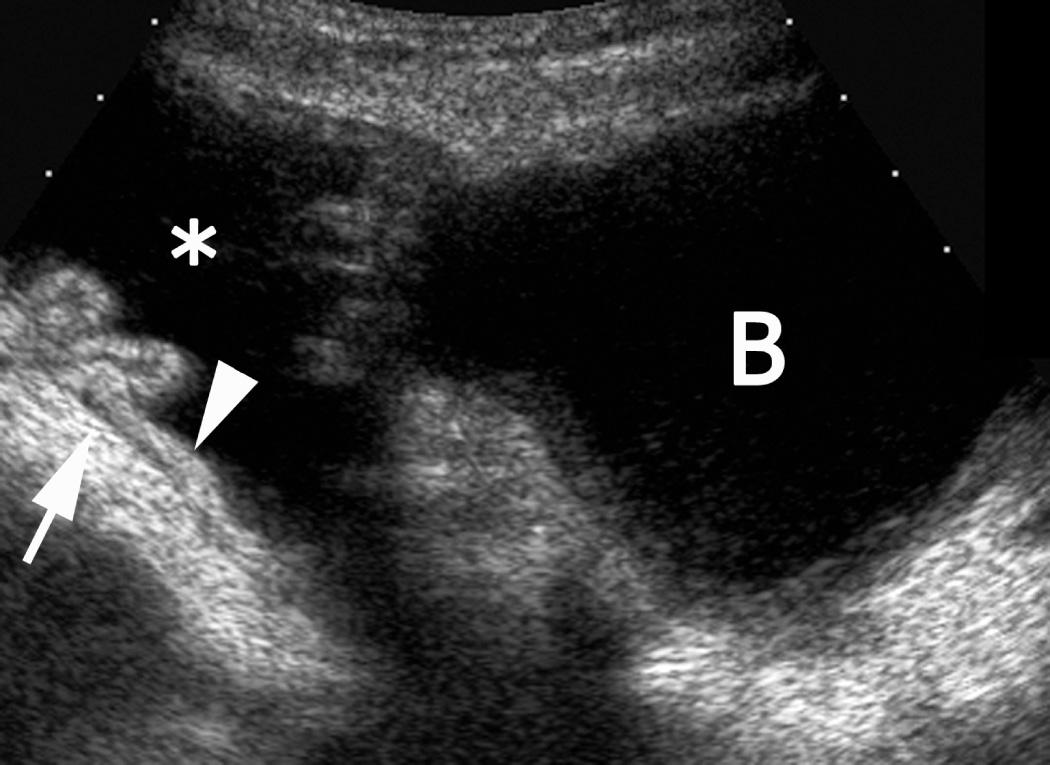
The fetal urachus is a tubular structure extending from the umbilicus to the bladder. It normally closes by birth, and a urachal remnant may be visible as a hypoechoic, elliptical mass on the anterosuperior aspect of the bladder ( Fig. 52.23 ). A patent urachus is present if there is a complete tubular connection from the bladder to the skin surface at the umbilicus (about 50%), or only a portion may be open as a blind-ending urachal sinus arising either from the bladder dome ( vesicourachal diverticulum, about 3%-5%, Fig. 52.24 ) or from the umbilicus (umbilicourachal sinus, about 15%). When only the midportion of the urachus remains patient, a urachal cyst is the result (about 30%) ( Fig. 52.25 ).
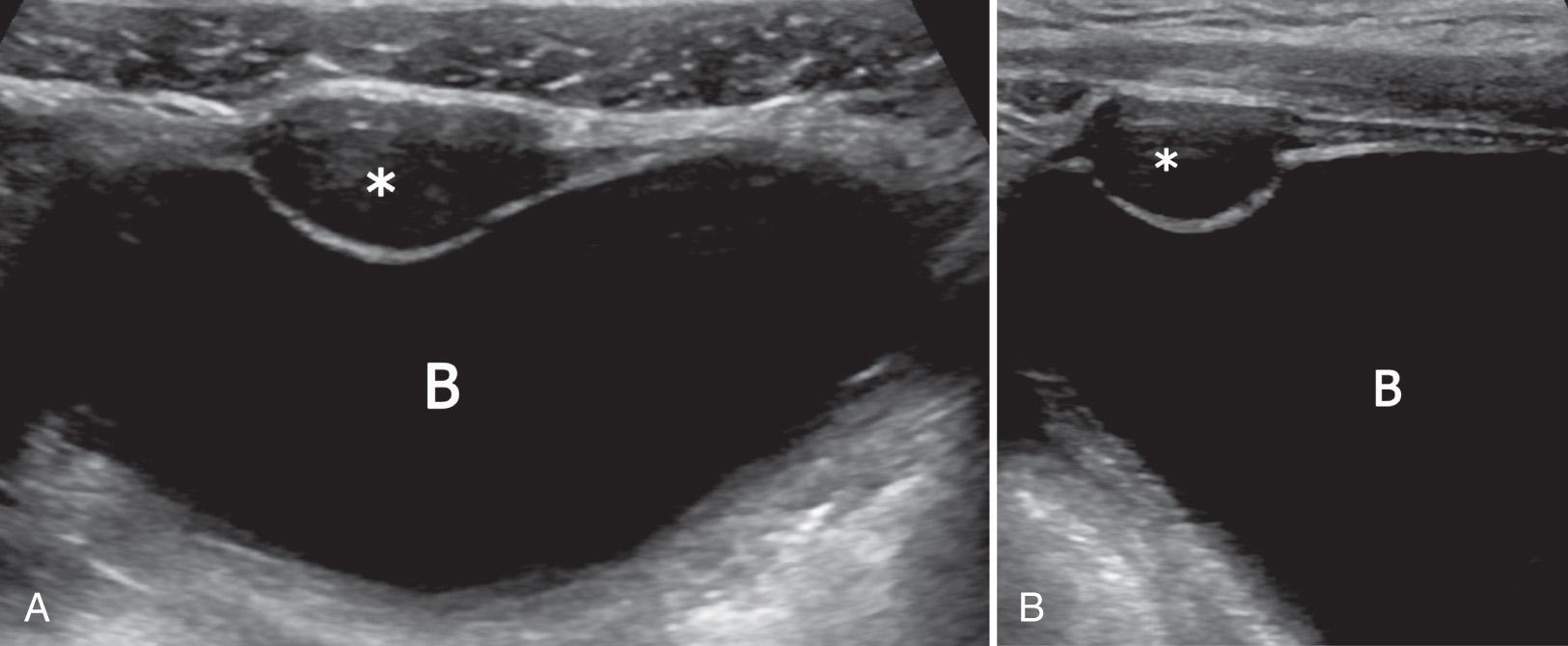
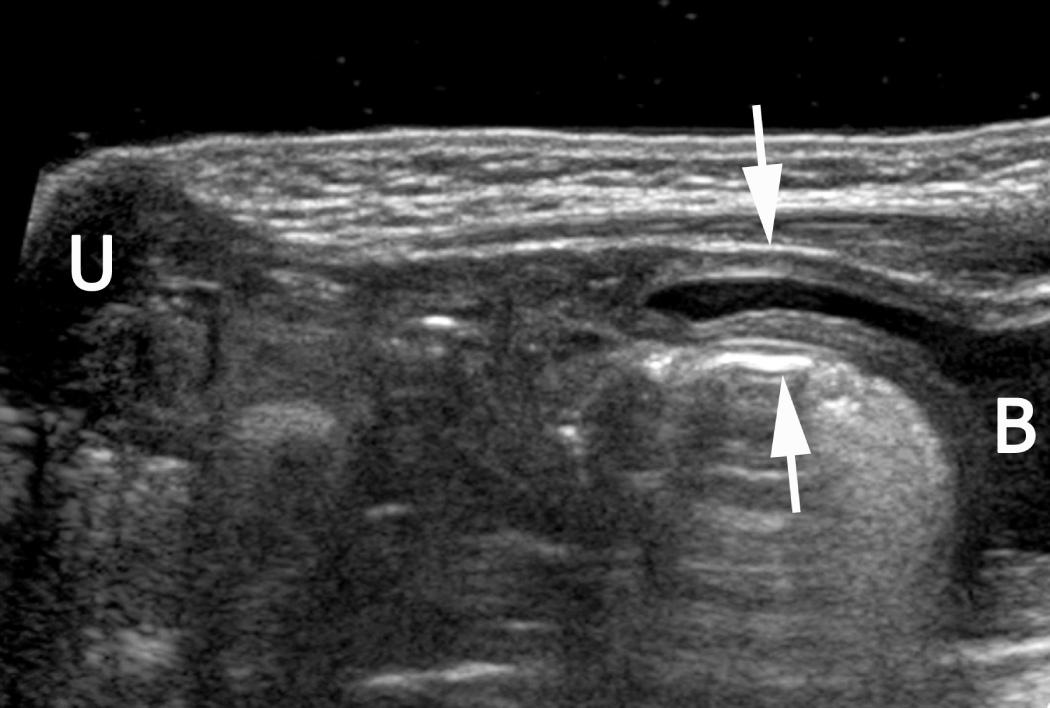

The literature is inconclusive on how to manage pediatric urachal lesions, especially those discovered incidentally. Both the therapeutic and the prophylactic value of surgical resection are ill defined. A recent retrospective review of 721 patients by Gleason and colleagues concluded that urachal anomalies are more common than previously reported, and that children with asymptomatic lesions do not appear to benefit from prophylactic excision, as the risk of malignancy later in life is remote.
UTI is a common clinical problem in children and a frequent indication for renal sonography. The imaging workup of the child with a UTI is usually performed after the first culture has documented infection in an infant or child. The purpose of the workup is to identify congenital anomalies, obstruction, and other abnormalities that may predispose the patient to infection. Sonography of the urinary tract, including the kidneys and bladder, is used for initial screening. VCUG is indicated after a first UTI only if ultrasound reveals hydronephrosis, scarring, or other abnormalities suggestive of high-grade VUR or obstructive uropathy or in patients with complex clinical conditions. VCUG is also recommended if there is a recurrence of a febrile UTI.
In most centers in the United States, conventional fluoroscopic VCUG is performed for evaluation of the bladder and urethra and to detect the presence of VUR. Nuclear cystography can also be used for diagnosis of VUR and is associated with a lower radiation dose to the gonads in boys. In some centers nuclear cystography is used as the initial study for girls with normal renal and bladder sonograms, because girls rarely have urethral abnormalities. Some centers also use it to follow reflux in all children. At Boston Children's Hospital, we recently introduced contrast-enhanced VCUG and plan to eventually pilot its use in the follow-up of patients with prior VCUG documentation of VUR, as an initial imaging study in selected patients with normal ultrasound imaging of the kidneys and bladder, and in patients whose parents have serious concerns about radiation exposure (see Fig. 52.20 , , , ).
Diuretic renography with MAG3 can be performed to differentiate between obstructive and nonobstructive causes of renal or ureteral dilation, and to assess renal function. Renal nuclear scintigraphy with 99m Tc dimercaptosuccinic acid (DMSA) is extremely sensitive for demonstrating focal areas of inflammation and parenchymal scarring. Although mild scarring may be missed with sonography, power Doppler sonography increases the sensitivity of scar detection. Because mild scars do not alter the course of therapy, the radiation dose of a renal cortical scan is not required and the increased time and expense of Doppler sonography may also be avoided.
Acute pyelonephritis is one of the most serious bacterial illnesses of childhood. It may be diagnosed clinically in patients with a sudden onset of fever, flank pain, costovertebral angle tenderness, and microscopic evidence of urinary infection. VUR is clearly a risk factor for the development of acute pyelonephritis, which often starts as an ascending infection from the bladder. It can also occur by hematogenous spread. In infants, symptoms are often ambiguous, and fever is not always helpful in identifying patients at risk for complications of acute pyelonephritis such as sepsis and meningitis.
In general, there are few findings of acute pyelonephritis on conventional gray-scale sonography. There may be swelling of the infected kidney and altered renal parenchymal echogenicity from edema causing triangular areas of increased echogenicity or rounded hypoechoic zones. Focal pyelonephritis can appear sonographically as a localized mass with abnormal echogenicity compared with the remainder of the kidney and loss of corticomedullary differentiation ( Fig. 52.26 ). There may be thickening of the wall of the renal pelvis and ureter, also caused by edema and inflammation ( Fig. 52.27 ). Sequential examinations of these focal infected areas will typically demonstrate a rapid change, with resolution of the mass in response to antibiotic therapy.
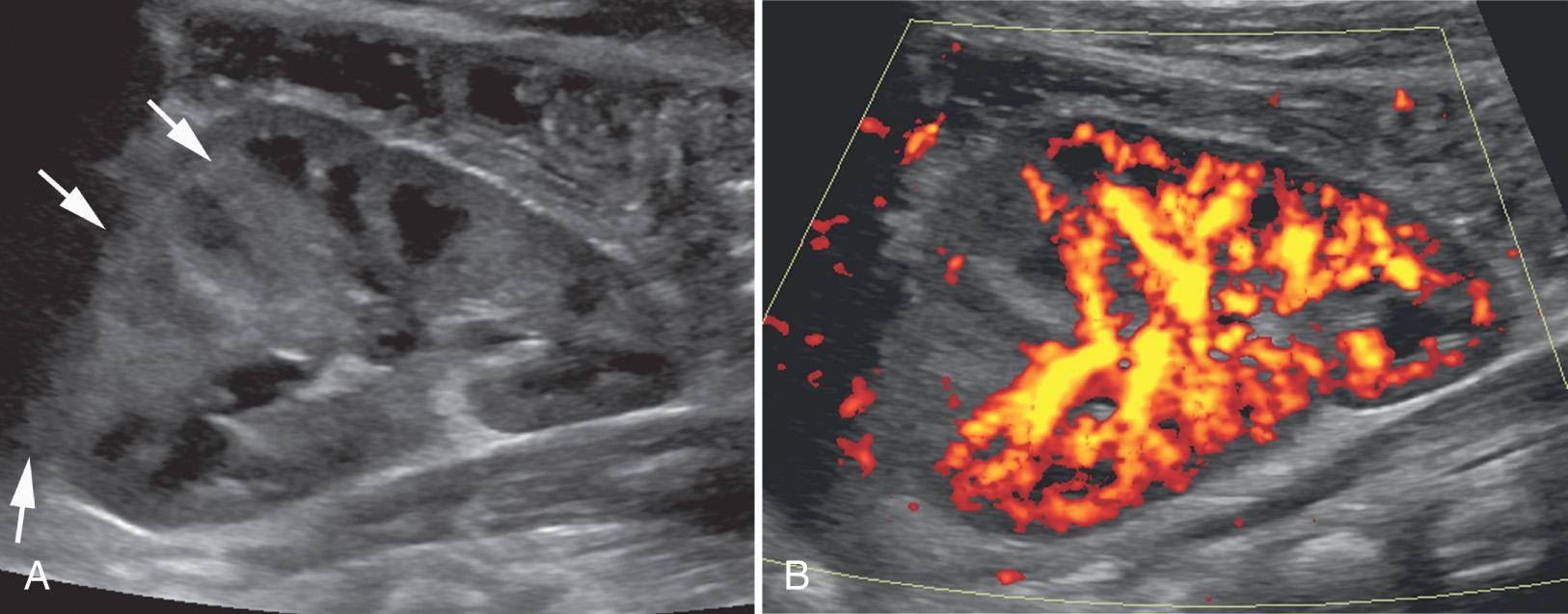
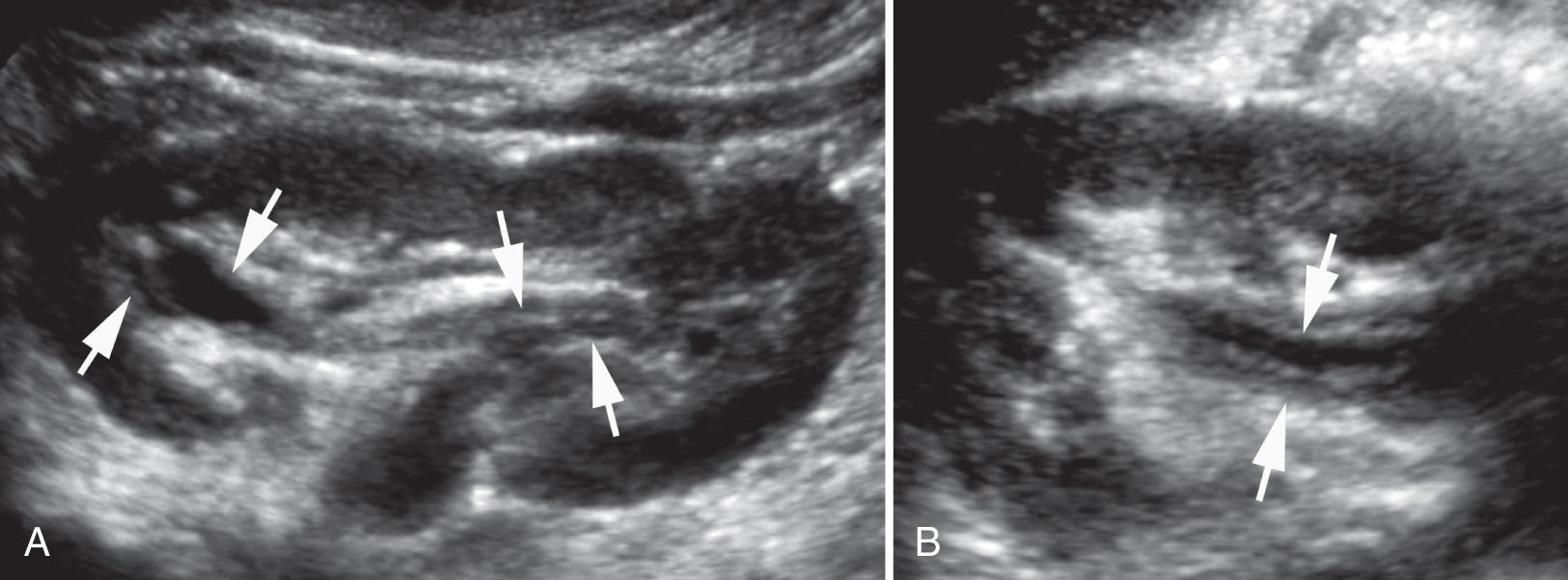
Power Doppler sonography, DMSA scintigraphy, computed tomography (CT), and magnetic resonance imaging (MRI) may all show absent or decreased perfusion in a diffuse or lobar distribution, especially in the upper or lower poles. CEUS has also been used to identify adults with acute pyelonephritis, but there have been no reports yet regarding its use in children. When patients with UTIs do not respond rapidly to antibiotic therapy, repeat sonographic and/or CT examinations are indicated to search for complications that require drainage.
Acute lobar nephronia is a localized, nonliquefactive, severe interstitial bacterial infection of the renal parenchyma. Sonography may demonstrate a focal mass of variable echogenicity with ill-defined borders. CT is considered a more sensitive and accurate imaging modality for the diagnosis of acute lobar nephronia. Affected patients have a more protracted clinical course than those with acute pyelonephritis, and there is a higher incidence of renal scarring. If response to antibiotic therapy is inadequate, the mass may liquefy centrally and become a renal abscess that requires drainage. Sonography of an abscess shows a focal mass with a hypoechoic central area representing liquefied pus ( Fig. 52.28 ).

Another potential complication of acute pyelonephritis that requires drainage is pyonephrosis, which appears on sonography as echogenic material filling a dilated collecting system ( Fig. 52.29 ).
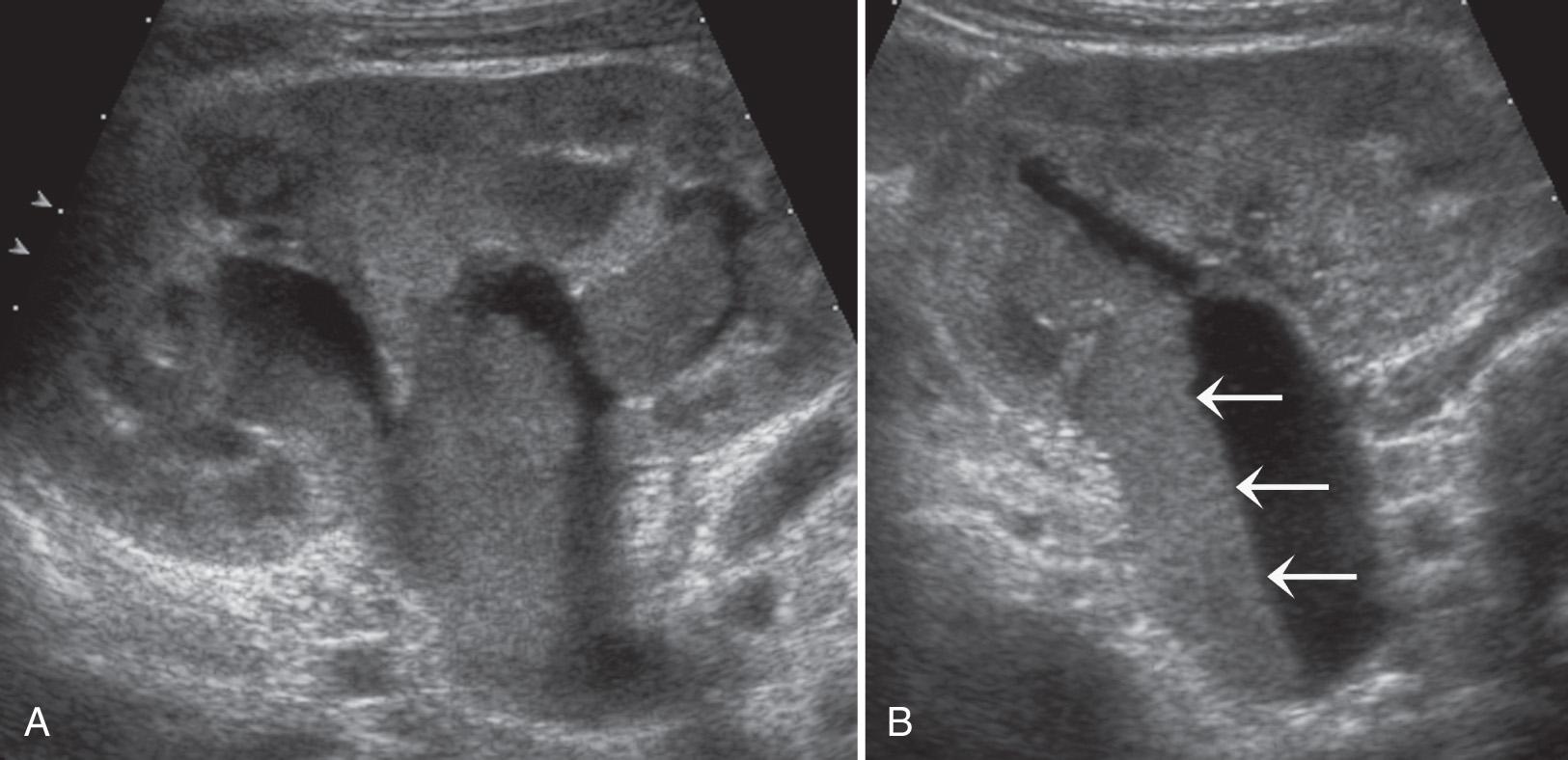
Chronic pyelonephritis is caused by repeated episodes of acute pyelonephritis and results in a small, scarred kidney, indicative of end-stage renal disease. The kidney is usually irregular in outline because of focal parenchymal loss. The renal cortex is typically more echogenic than the adjacent hepatic or splenic parenchyma, and there may be decreased corticomedullary differentiation ( Fig. 52.30 ). These findings are not specific and can also be seen in children with chronic glomerulonephritis, renal dysplasia, hypertension, or renal ischemia.
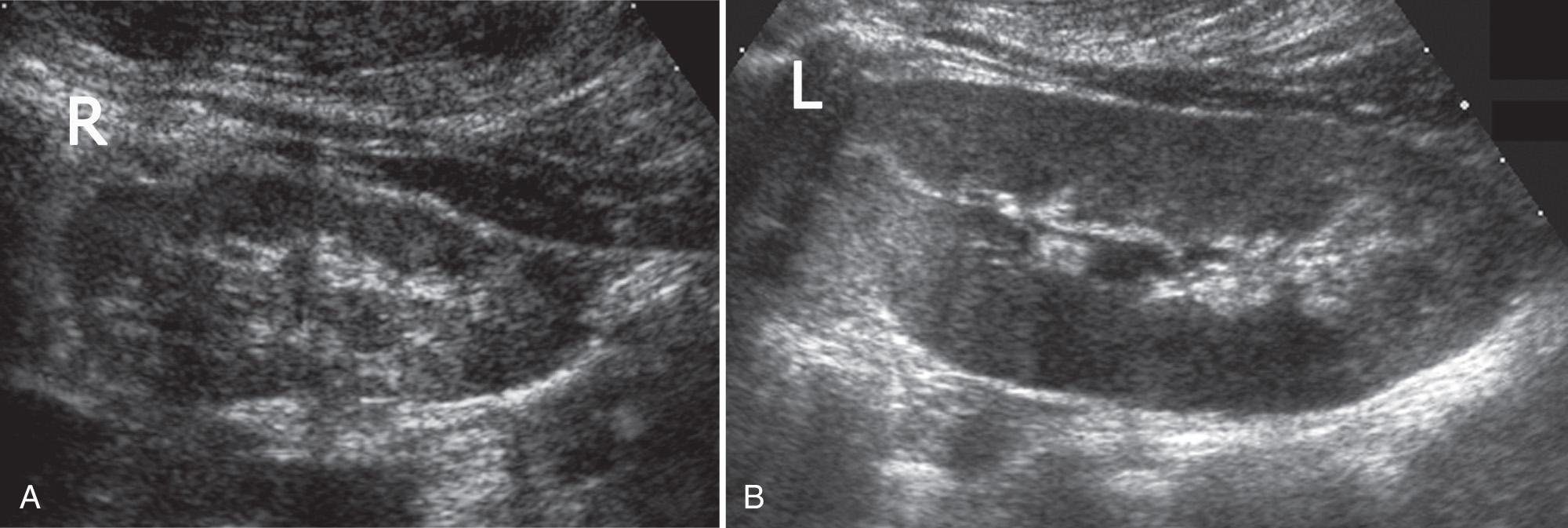
Candida albicans is a saprophytic fungus that usually infects immunocompromised patients, particularly neonates with indwelling catheters receiving broad-spectrum antibiotics. Systemic candidiasis leads to infection of multiple organs, including the kidneys, and neonates may have anuria, oliguria, a flank mass, or hypertension. Sonography may show diffuse enlargement of the kidney, with loss of normal architecture and increased parenchymal echogenicity. Fungus ball formation due to mycelial clumping may occur in the collecting system, resulting in echogenic masses and hydronephrosis secondary to obstruction ( Fig. 52.31 ).
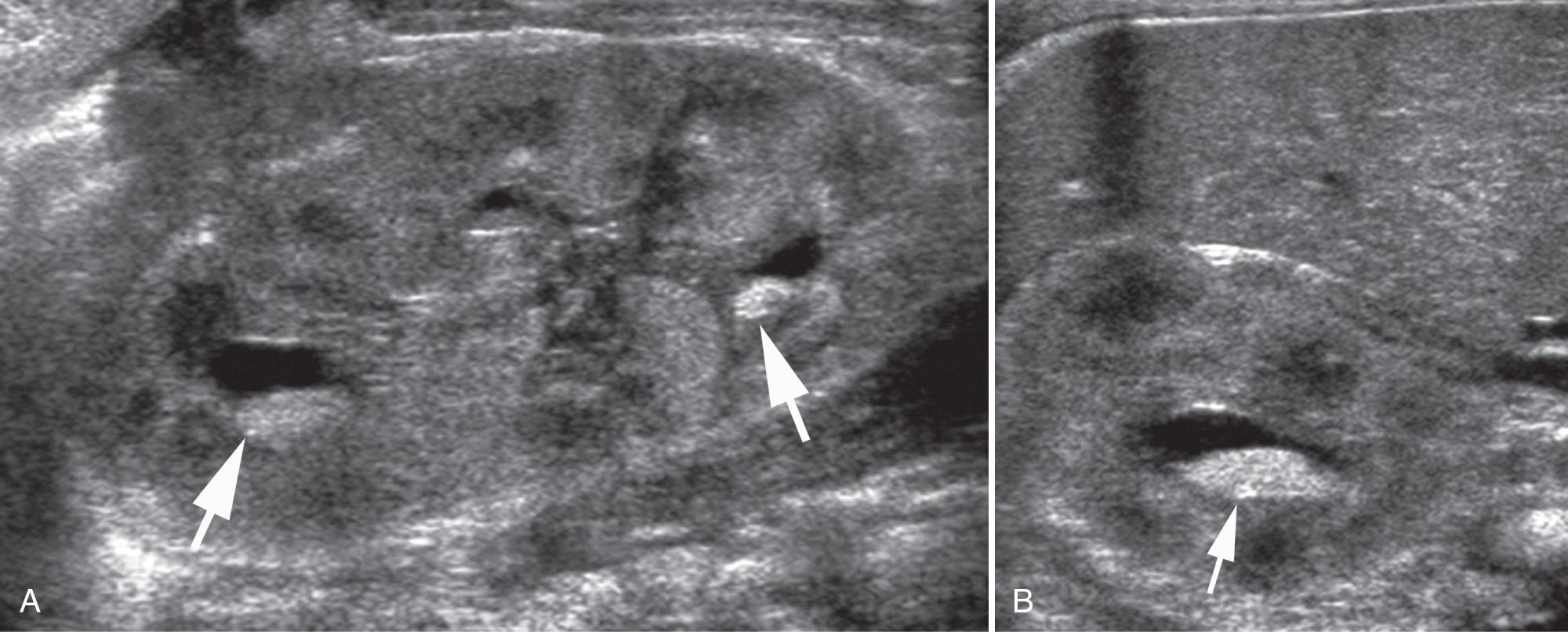
Inflammation of the urinary bladder may occur in children as a result of infection or drug therapy, as with the antineoplastic agent cyclophosphamide. The bladder wall becomes thickened and irregular, with hypervascularity identified with color and power Doppler imaging. Echogenic debris or blood clot may be seen in the bladder lumen ( Fig. 52.32 ). Rarely, an inflammatory pseudotumor may result, with visualization of a bladder mass ( Fig. 52.33 , ).
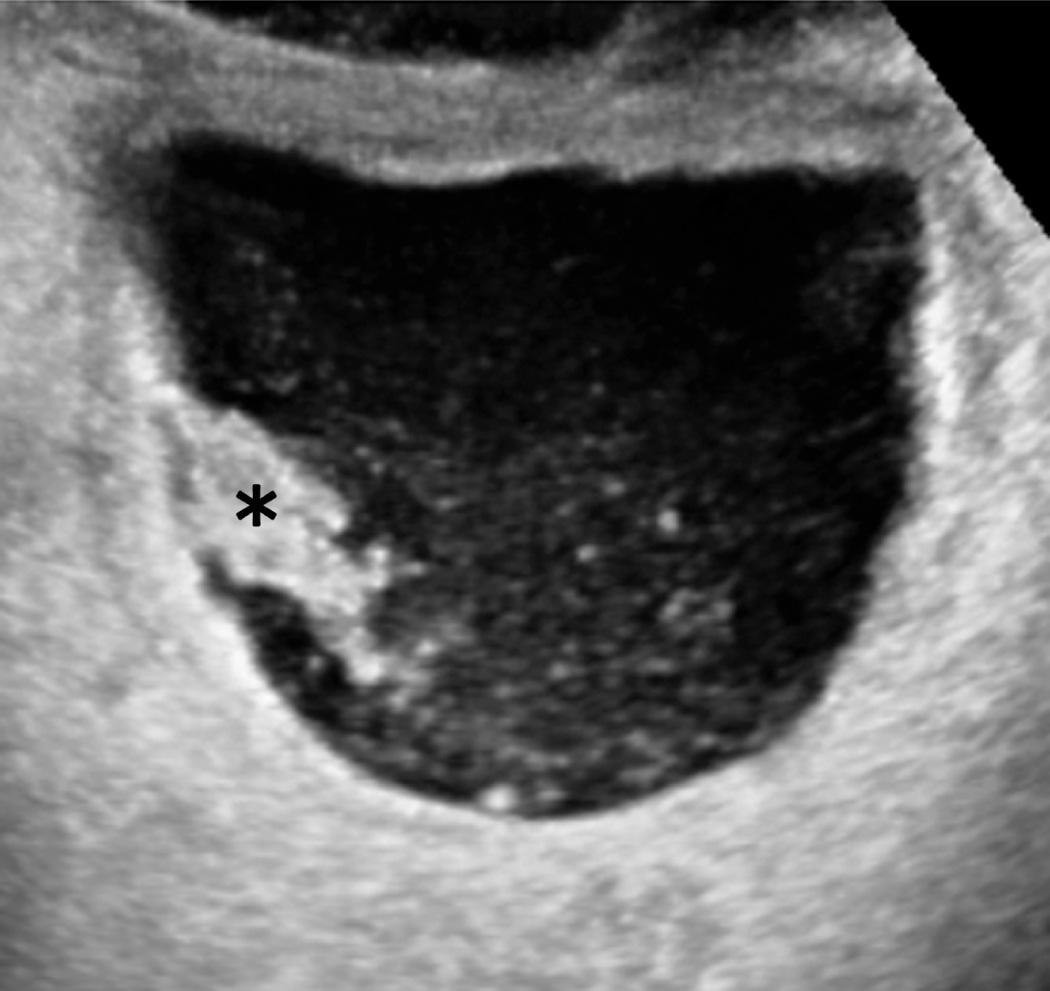
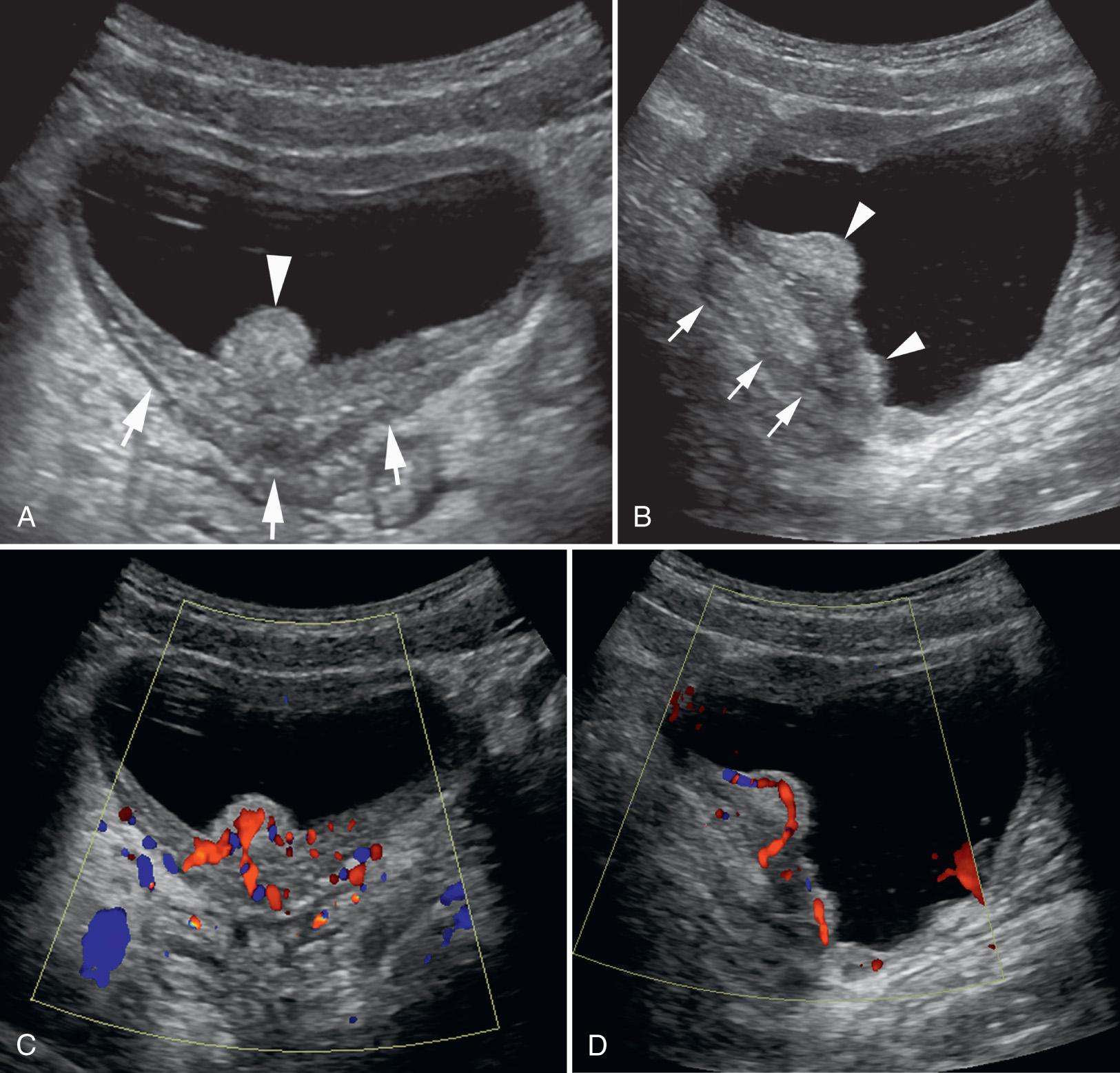
The term “medical renal disease” refers to disorders that primarily affect the renal parenchyma and may be acute or chronic. Ultrasound is usually the initial imaging study performed in the evaluation of patients who typically have hematuria, proteinuria, or renal failure.
Acute kidney injury (AKI), defined as a sudden loss of renal function, may be caused by inadequate renal perfusion, renal cell injury, or urinary tract obstruction. AKI usually develops in hospitalized children as a consequence of systemic illness or its treatment, and not from primary renal disease. The most common causes of AKI in children are renal ischemia, nephrotoxic drugs, and sepsis. Other important causes are listed in the accompanying box. All forms of AKI can lead to chronic kidney disease (CKD). Recovery of renal function depends on the underlying events leading to injury.
Decreased true intravascular volume
Decreased effective intravascular volume
Acute tubular necrosis (vasomotor neuropathy)
Hypoxic or ischemic insults
Drug induced
Toxin mediated
Endogenous toxins—hemoglobin, myoglobin
Exogenous toxins—ethylene glycol, methanol
INTERSTITIAL NEPHRITIS
Drug induced
Idiopathic
Become a Clinical Tree membership for Full access and enjoy Unlimited articles
If you are a member. Log in here